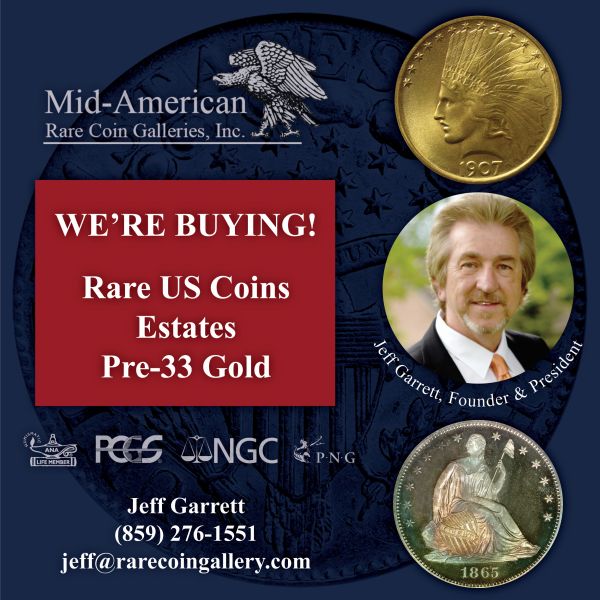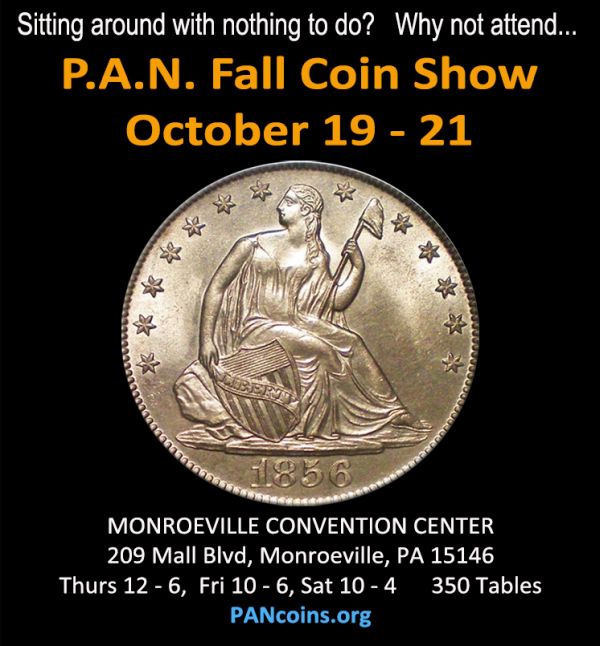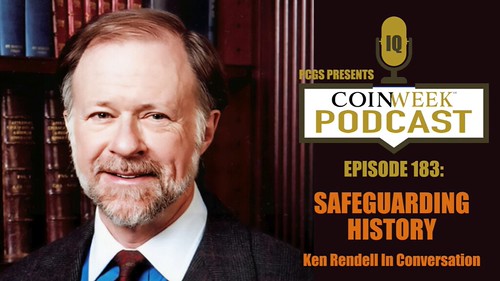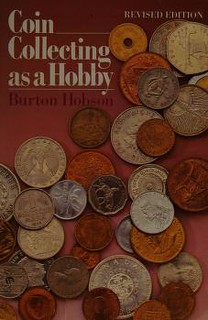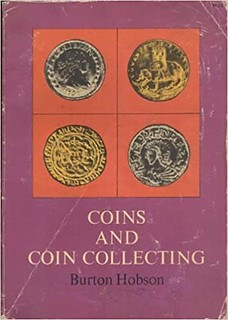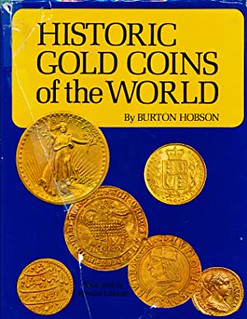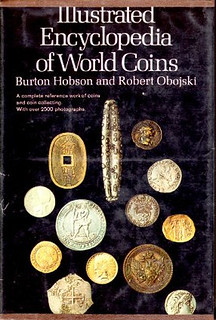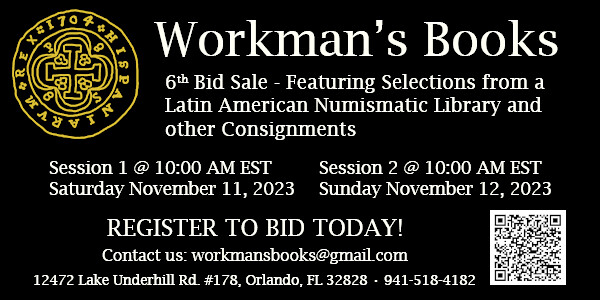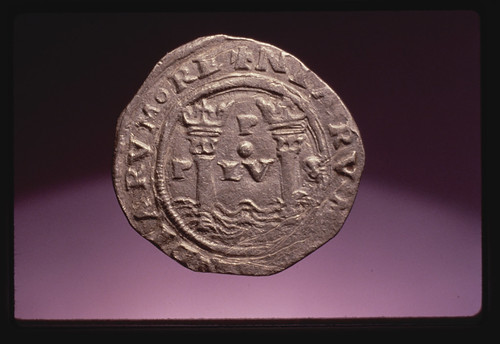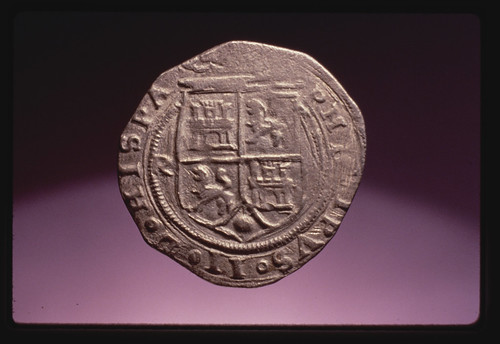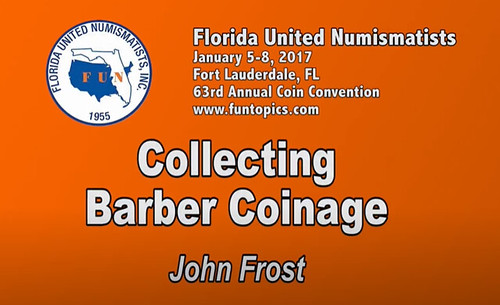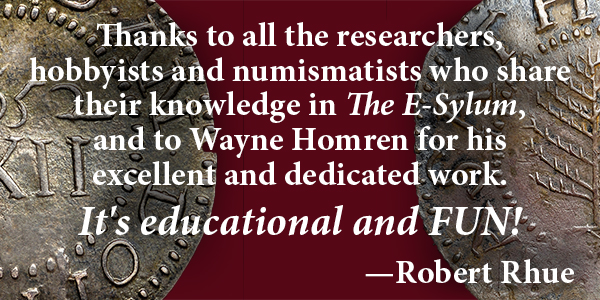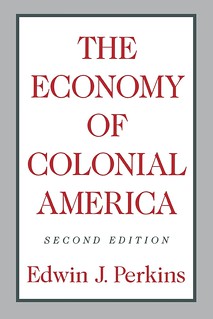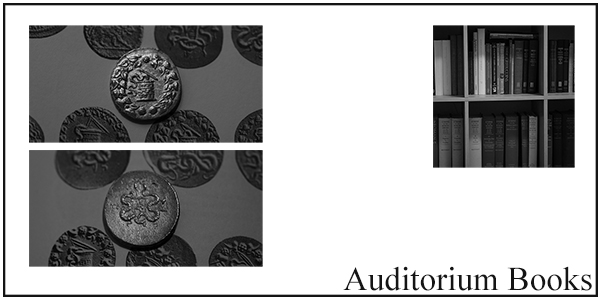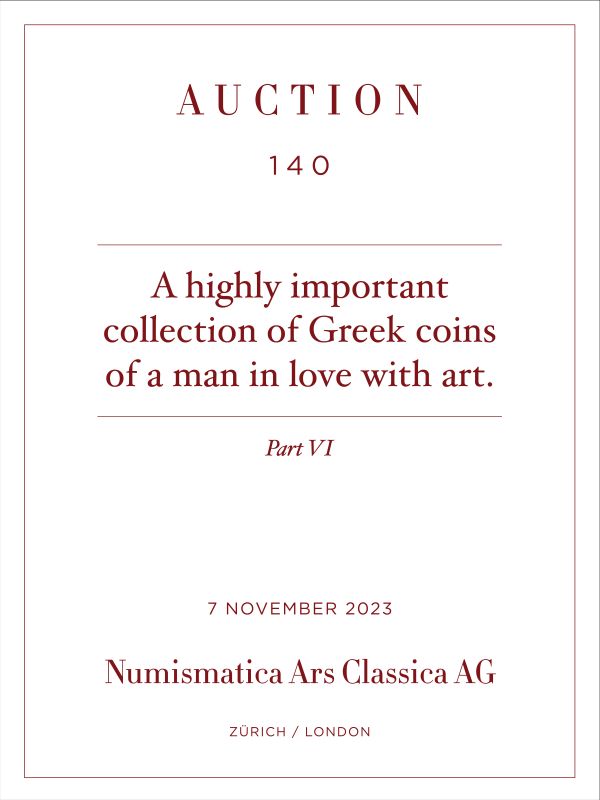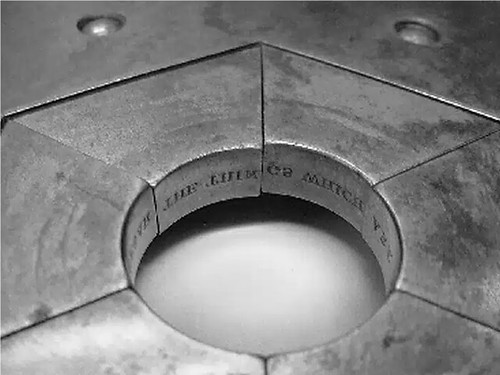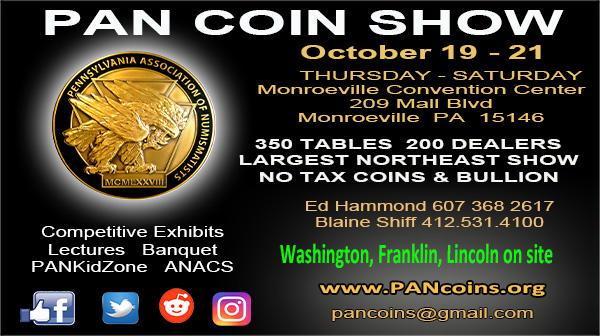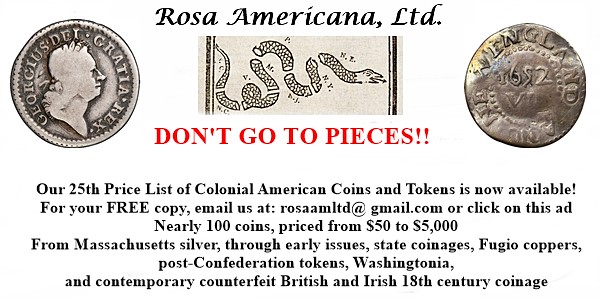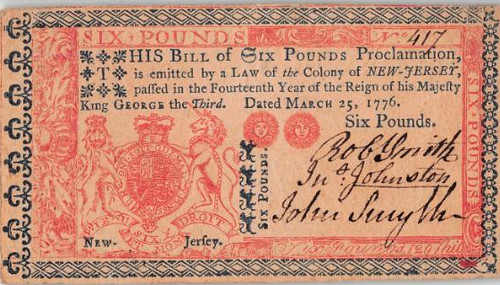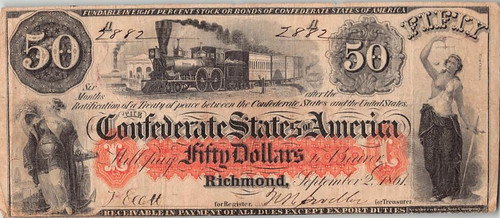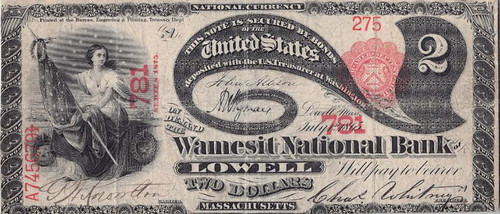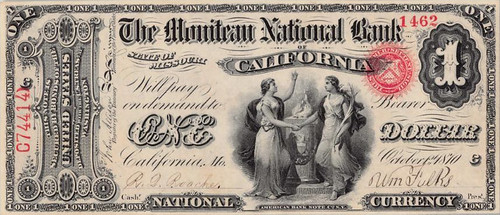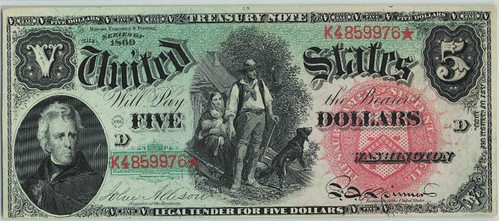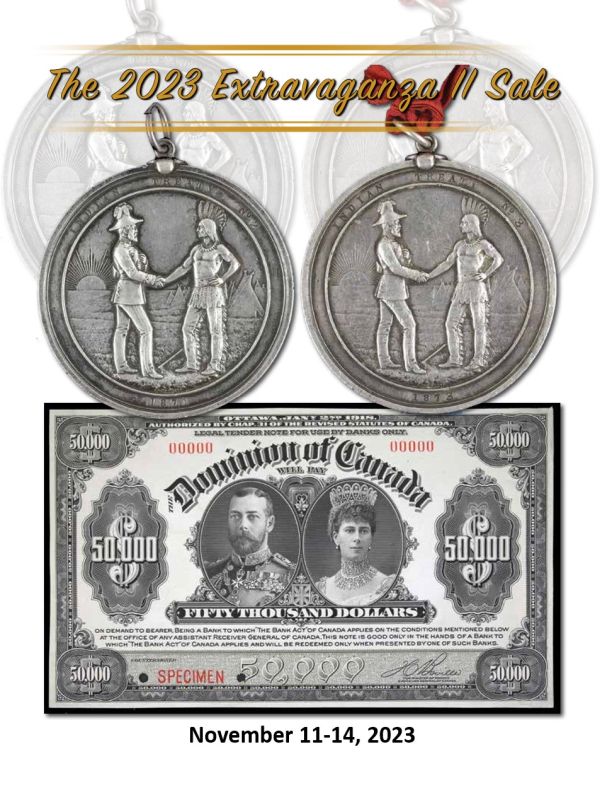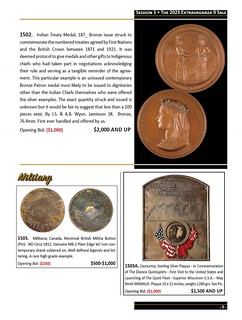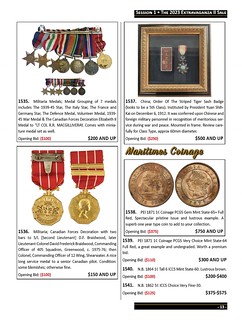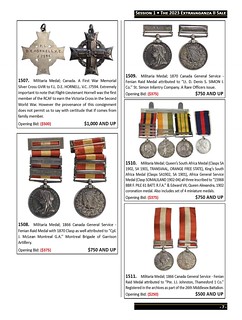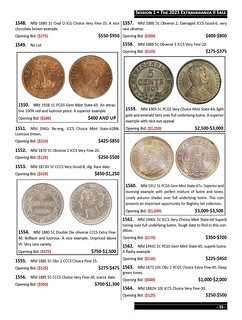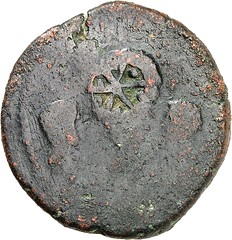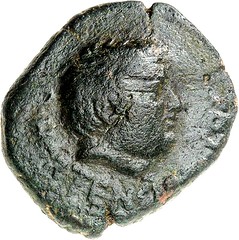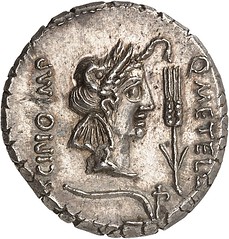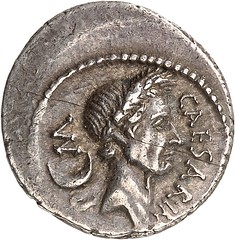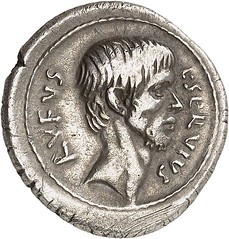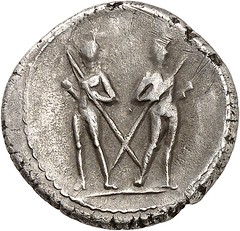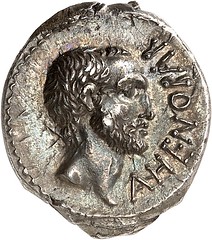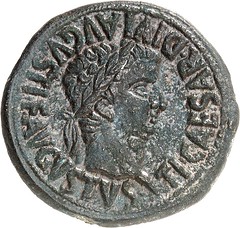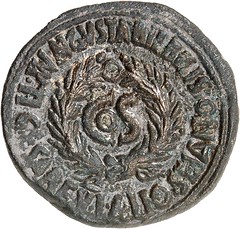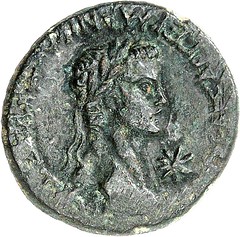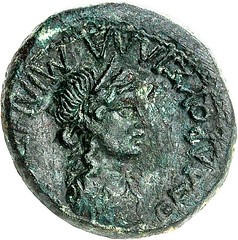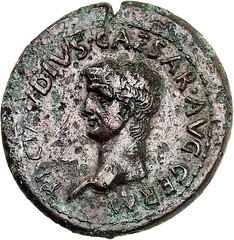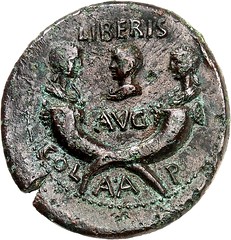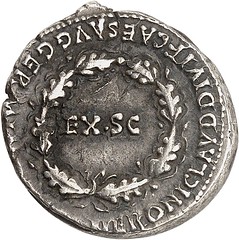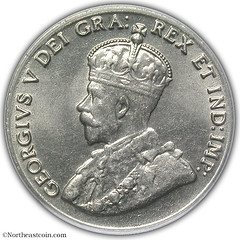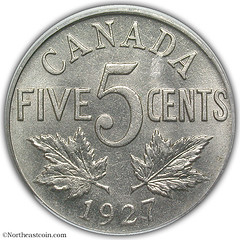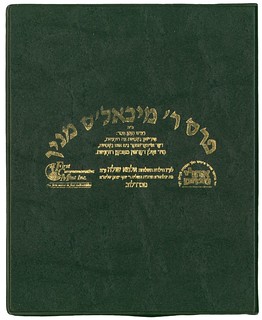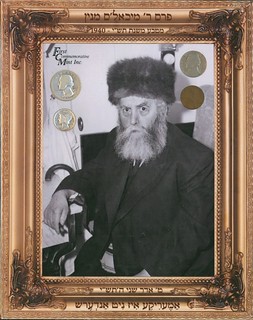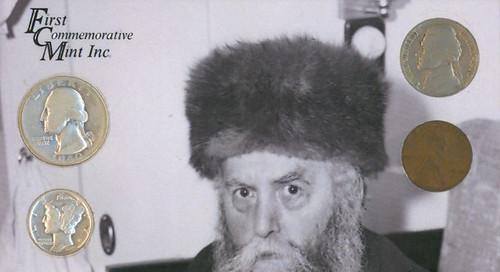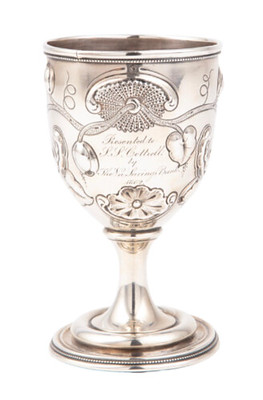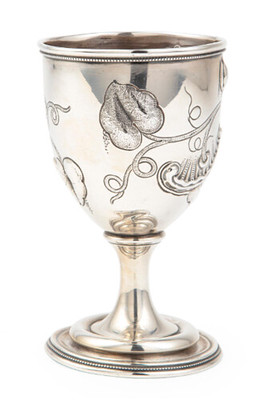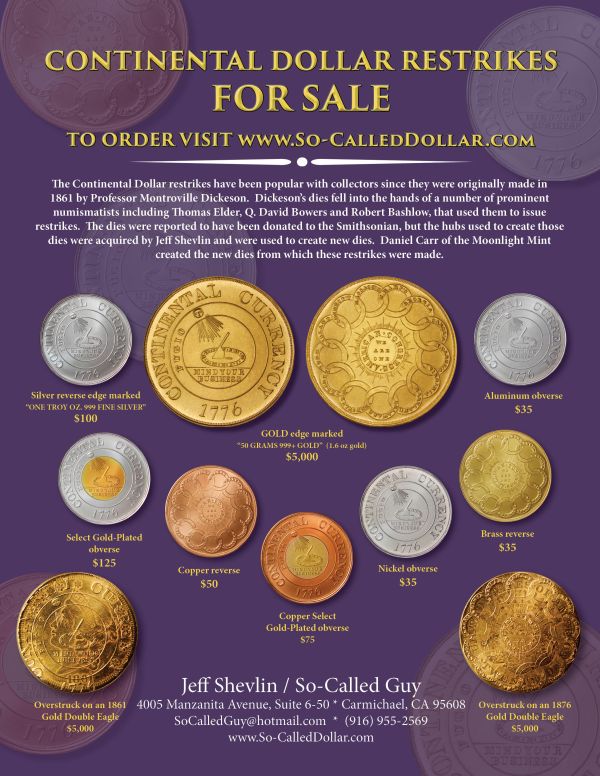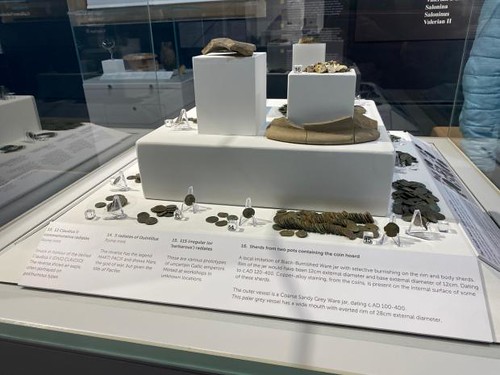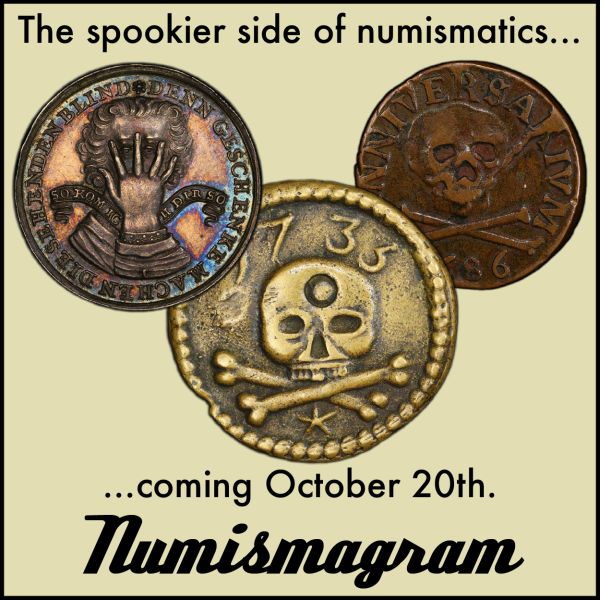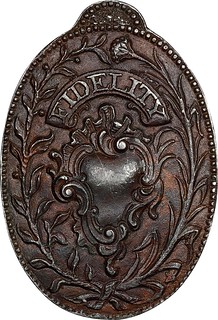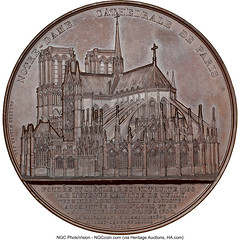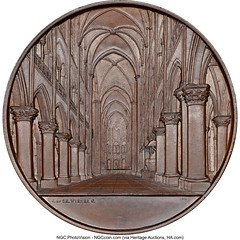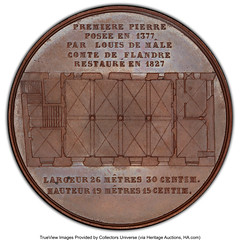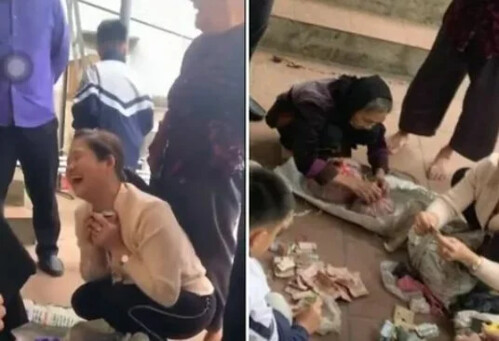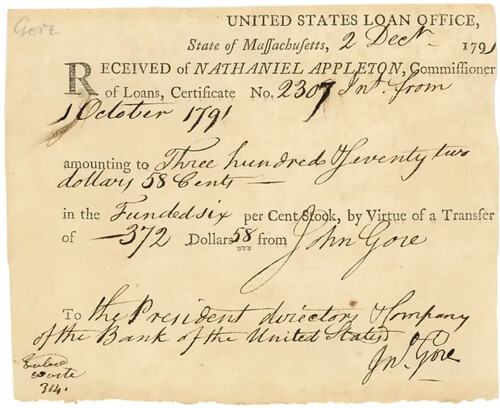
Visit our NBS Sponsors
About UsThe Numismatic Bibliomania Society is a non-profit association devoted to the study and enjoyment of numismatic literature. For more information please see our web site at coinbooks.org SubscriptionsThose wishing to become new E-Sylum subscribers (or wishing to Unsubscribe) can go to the following web page link MembershipThere is a membership application available on the web site Membership Application To join, print the application and return it with your check to the address printed on the application. Print/Digital membership is $40 to addresses in the U.S., and $60 elsewhere. A digital-only membership is available for $25. For those without web access, write to: Jeff Dickerson, Treasurer AsylumFor Asylum mailing address changes and other membership questions, contact Jeff at this email address: treasurer@coinbooks.org SubmissionsTo submit items for publication in The E-Sylum, write to the Editor at this address: whomren@gmail.com BUY THE BOOK BEFORE THE COINSale Calendar |
- WAYNE'S WORDS: THE E-SYLUM OCTOBER 15, 2023
- NEW BOOK: SATAVAHANA COINS FROM PEDDABONKUR
- NEW BOOK: TELEPHONE TOKENS OF NORTH AMERICA
- NEW BOOK: GERMAN EMERGENCY COINS 9TH ED.
- NEW BOOK: CANADIAN BANK NOTES 10TH EDITION
- NEW BOOK: PAPER MONEY OF CONGO
- PODCASTS: KEN RENDELL IN CONVERSATION
- BURTON H. HOBSON (1933-2023)
- TIMOTHY HAROLD LAPOINTE (1947-2023)
- NNP ADDS COINAGE OF EL PERÚ SLIDE SET
- VIDEO: COLLECTING BARBER COINAGE
- POBJOY MINT TO CLOSE
- NOTES FROM E-SYLUM READERS: OCTOBER 15, 2023
- HEARTLAND CSNA EDUCATIONAL SYMPOSIUM
- VOCABULARY TERM: OPEN FACE DIE
- EDGE COLLARS
- RON GILLIO INTERVIEW, PART TWO
- NGC INTERVIEW: DON EVERHART
- WBNA US CURRENCY SALE FOUR
- SEDWICK TREASURE AUCTION 34 ANNOUNCED
- TCNC 2023 EXTRAVAGANZA II SALE
- KUENKER AUCTIONS 395-397, PART 1
- NUMISMATIC NUGGETS: OCTOBER 15, 2023
- NORRIS MUSEUM DISPLAYS THE MUDDY HOARD
- HAN DYNASTY COIN HOARD FOUND
- COIN HOARD LINKED TO 1692 GLENCOE MASSACRE
- NEW KING CHARLES III COINS ANNOUNCED
- WYATT COPY OF MAJOR ANDRE MEDAL OFFERED
- HERITAGE OFFERS ARCHITECTURAL MEDALS
- FORGOTTEN THAILAND BANKNOTE HOARD FOUND
- COIN TOSS ODDS? NOT 50/50
- NUMISMATIC SMALL TALK
- FEATURED WEBSITE: THE HERBSTMAN COLLECTION
Content presented in The E-Sylum is not necessarily researched or independently fact-checked, and views expressed do not necessarily represent those of the Numismatic Bibliomania Society.
WAYNE'S WORDS: THE E-SYLUM OCTOBER 15, 2023
 New subscribers this week include:
Charlie Baxter.
Welcome aboard!
New subscribers this week include:
Charlie Baxter.
Welcome aboard!
Are we getting too big for our britches? Several readers have reported difficulty receiving their emailed issues. AOL, Yahoo and other email services haven't always been delivering our emails. While I understand why these companies don't reveal the details of their spam policies (they don't want to tell spammers what to avoid), it's greatly frustrating for legit senders like us - they reject you but never tell you why. So we have to guess. I hate to brag, but are we too ... BIG?
This week we'll experiment by sending everyone TWO issues - one the normal E-Sylum, chock full with 33 articles, the other a minimal version with just these Wayne's Words and links to the issue online. Perhaps this smaller version will arrive. If it does and you hadn't been receiving these for a bit, please let me know. Contact me at whomren@gmail.com anytime regarding your subscription, or questions, comments or suggestions about our content.
This week we open with five new books, two obituaries, updates from the Newman Numismatic Portal, new podcasts and more.
Other topics this week include telephone tokens, banknotes of Canada and Congo, Barber coinage, coin dies, edges and collars, the Pobjoy Mint, Ron Gillio, Don Everhart, auction previews, coin and paper money hoards, the Capture of Andre medal, architectural medals, and coin tossing.
To learn more about German emergency coins, Ken Rendell, Burton Hobson, Tim LaPointe, the Numismatic Proof Scale, Comitia Americana medals, the Muddy Hoard, new coins for King Charles III, numismatic small talk and the Herbstman Collection of American Finance, read on. Have a great week, everyone!
Wayne Homren
Editor, The E-Sylum
NEW BOOK: SATAVAHANA COINS FROM PEDDABONKUR
A new book has been published on coinage of the ancient Indian Satavahana dynasty. -Editor
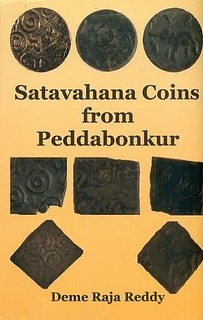 One of the most illustrious dynasties of ancient India, the Satavahanas ruled over Dakshinapatha and central India and they left behind such great works of art as the famous Sanchi and Amaravathi stupas and rock cut temples in western India. During their long rule Satavahana dynasty provided peace, prosperity through foreign trade and they patronized a kind of art which flourished for many centuries. Hence it was no surprise that Satavahana period and Indus valley period are listed as the two times of peace and prosperity in 5000 year history of our country. The discovery of Kotalingala coins in 1978 conclusively proved that the birth place of Satavahanas was Telangana and Kotalingala was their first capital.
One of the most illustrious dynasties of ancient India, the Satavahanas ruled over Dakshinapatha and central India and they left behind such great works of art as the famous Sanchi and Amaravathi stupas and rock cut temples in western India. During their long rule Satavahana dynasty provided peace, prosperity through foreign trade and they patronized a kind of art which flourished for many centuries. Hence it was no surprise that Satavahana period and Indus valley period are listed as the two times of peace and prosperity in 5000 year history of our country. The discovery of Kotalingala coins in 1978 conclusively proved that the birth place of Satavahanas was Telangana and Kotalingala was their first capital.
There are very many Satavahana sites in Telangana besides Kotalingala such as Kondapur, Nagarjunakonda, Peddabonkur, Dhulikatta, Phanigiri etc. Now where in the country that many thousands of Satavahana coins were found on the surface and also in excavations conducted at Peddabonkur. This monograph is an effort to study the Satavahana coins found at Peddabonkur and what could be learned from the study of coins and antiquities found at this site and nearby Dhulikatta. It may be of interest to know that coins of early rulers of Satavahana including its founder were found at Kotalingala and coins of later Satavahana rulers including their last ruler were found at Peddabonkur.
Contents: 1. Introduction. 2. Obverse symbols on Peddabonkur Coins. 3. Reverse symbol on Peddabonkur Coins. 4. Legends on Peddabonkur Coins. 5. Shapes, Sizes and weights of Peddabonkur Coins. 6. Post-Satavahana coins. 7. Ruler wise description of Satavahana coins found at Peddabonkur. 8. Satrap coins. 9. Religions of the period. 10. Satavahana coins found during excavations around the country. 11. Excavations at Peddabonkur and neighboring Dhulikatta, reports of coins. 12. An analysis of coins, antiquities and other cultural materials found at Peddabonkur and Dhulikatta. 13. Epilogue and conclusion. References. Annexures.
For more information, or to order, see:
Satavahana coins from Peddabonkur - Hardcover
(abebooks.co.uk/products/isbn/9789391123567)
Satavahana Coins from Peddabonkur
(https://www.exoticindiaart.com/book/details/satavahana-coins-from-peddabonkur-ubc686/)
Satavahana Coins from Peddabonkur
(https://www.bagchee.com/books/BB137386/satavahana-coins-from-peddabonkur-)
THE BOOK BAZARRE
NEW BOOK: TELEPHONE TOKENS OF NORTH AMERICA
Robert Gilbert is publishing a new book on the telephone tokens of North America. Here's the announcement. -Editor
 Telephone Tokens of North America
Telephone Tokens of North America
Robert Gilbert
Telephone tokens from 7 North American countries
- 270 pages - 94 issuers of tokens
- 485 tokens plus die varieties
- Full token descriptions (size, thickness, weight, die orientation, etc.) with color photos
$55.00 thru Dec 1, 2023 + $5.00 shipping to USA
Email for shipping to other countries
Shipping in Dec.
After that, available on Amazon at higher price
Mail check to:
Robert Gilbert, P.O. Box 299
Liberty Corner, NJ 07938
parlayguy@gmail.com
Robert adds:
"I'm working on the final read through of the catalogue; and hope to complete that in the next couple of weeks. Then I will get a proof copy from the printer to make sure everything looks good, and to get the weight of the printed book. This will allow me to determine postage for those who ask about shipping outside of the US. From my estimates, shipping outside the US will be fairly expensive. I hope that people can order through Amazon so that shipping will not be a problem; however, I don't know how they charge for shipping outside the US.
"I decided to have this catalogue cover North America to include Canada along with the US. Then I realized I could cover a few more countries is I use the list of North American countries defined by the UN Statistics Division. That list (which I included in the book) covers 48 countries. I know of telephone tokens from The Bahamas, Bermuda, Canada, Jamaica, Mexico, Panama and the US. I've tried to discover telephone tokens from other countries in this list, but did not find any.
"In the catalogue, I define my criteria of a telephone token. Some may disagree with this definition; however, those who wish can ignore tokens that they think are not telephone tokens.
"In some cases it is not clear if a specific token was used for telephone service. I've separated those tokens for which I have doubt in a separate section of the catalogue identifying these "suspect" telephone tokens.
"The listing of each token includes a full description of the obv and rev along with diameter, thickness, weight, shape, die orientation, border treatment and edge treatment; along with a color picture of the obverse and reverse. Where necessary I include closeup pictures to identify details. There are some tokens for which I don't have a picture. Also I include notes to help define the token. I include references/catalogue numbers used in other catalogues. There is a cross reference which allows one to convert other catalogue numbers to my catalogue.
"The tokens within each country are listed by issuer alphabetically (not by location within the country, e.g., not by state). I include a short description of each issuer; whether they be a telephone company, merchant or some other entity.
"I do NOT include a rarity guide. I've found over recent years that rarity determinations can change; especially given the use of eBay and other auction site and with the use of Internet communities like WoC. I am thinking about creating a separate rarity guide which can easily be updated periodically as new information is uncovered.
"The catalogue does include a complete listing of the Goetz/Yale Slot and Slug tokens (catalogued in Frank Earl's "Slotted, Grooved, & Punched"). These tokens consume about 80 of the 270 pages of the catalogue. I list several tokens and die varieties not covered in Earl.
"Speaking of die varieties, I include many die varieties in a manner that allows the collector to ignore these minor token differences if that is one's preference."
NEW BOOK: GERMAN EMERGENCY COINS 9TH ED.
A new 2024 edition of the standard catalog of German emergency coins has been published. Here's a Google-translated version of the publisher's page. -Editor
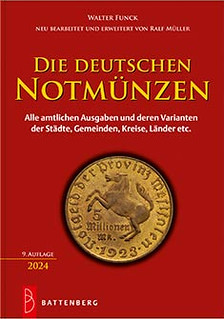 Die deutschen Notmünzen
Die deutschen Notmünzen
(The German emergency coins)
Walter Funck | Ralf Müller
All official editions and their variants of cities, municipalities, districts, states, etc.
ISBN: 978-3-86646-233-5
Edition: 9th edition 2024, newly edited and expanded by Ralf Müller
Dimensions: 14.8 x 21 cm
Type of figures: illustrated in black and white
Type of cover: Hardcover
Number of pages: 768
Price: 79.00 euros
- Complete catalog of all emergency coins issued between 1916 and 1923
- The standard catalog from Dr. Arnold Keller and Walter Funck fundamentally revised and expanded
The municipalities and cities tried to remedy this significant shortage of small change by first issuing paper emergency money from 1915 onwards. Since paper money quickly wore out and became unsightly, the first communities began to put metal emergency money into circulation at the end of 1916. These so-called small change replacement stamps
in official parlance were initially only tolerated and from the beginning of 1917 had to be officially approved by the responsible district offices under certain conditions.
In order to distinguish the emergency coins from the imperial coins, external characteristics such as size, shape or perforation were specified. In addition, the issuing offices had to deposit collateral equal to the issue amount in the form of securities (mostly war bonds) at the local Reichsbank branches.
For more information, or to order, see:
Die deutschen Notmünzen
(https://www.battenberg-gietl.de/produkt/die-deutschen-notmuenzen)
NEW BOOK: CANADIAN BANK NOTES 10TH EDITION
A new edition of Charlton's Canadian Bank Notes book has been published. Here's the information from the publisher's web site. -Editor
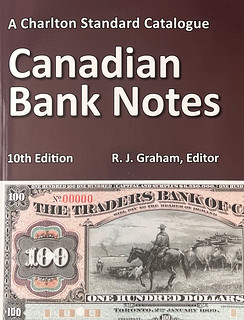 Canadian Bank Notes 10th Edition
Canadian Bank Notes 10th Edition
Editor: R. J. Graham
Format : 8.5" x 11"
Pages : 588
Binding : Perfect
$129.95
In the four years since the previous edition was published, the COVID pandemic has been with us for much of the time. It has had a positive impact on all kinds of collector entertainment, as people have been forced to spend less time in theaters, sports venues and other crowded places. The demand for entry-level bills, including small-format banknotes, continues and ensures the future of the hobby.
This book is an indispensable guide to Canadian chartered banknotes and their current market value, but it is also a source of practical and encyclopedic information, much of which is not available in other sources.
For more information, or to order, see:
Canadian Bank Notes 10th Edition
(https://www.charltonpress.com/collections/current-editions/products/canadian-bank-notes-10th-editions)
Charlton Standard Catalogue: Canadian Bank Notes, 10th Edition
(https://coinstampsupplies.com/product/charlton-standard-catalogue-canadian-bank-notes-10th-edition/)
NEW BOOK: PAPER MONEY OF CONGO
SPINK has published a new book on the paper money of Congo by Jean-Claude Martiny. -Editor
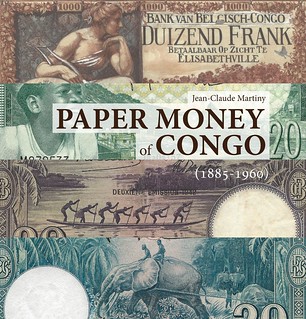 Paper Money of Congo
Paper Money of Congo
by Jean-Claude Martiny
Hardback, PPC, with full colour illustrations throughout
300 x 290mm portrait
672pp
£100.00
This book describes the history of all the treasury notes issued by the Congo Free State in 1896 and all the banknotes issued by the Bank of Belgian Congo from 1912 to 1952 and by the Bank of Belgian Congo and Ruanda-Urundi until Congo's independence in 1960.
Using unpublished archival documents from at home and abroad, all projects and actual issues are discussed in detail with the exception of the banknotes issued during the Second World War, since the Bank of Belgian Congo had relocated its activities to London and Kinshasa, and documents of that period appear to have been lost during the air raids on London.
For more information, or to order, see:
Paper Money of Congo by Jean-Claude Martiny
(https://spinkbooks.com/products/paper-money-of-congo-by-jean-claude-martiny)
PODCASTS: KEN RENDELL IN CONVERSATION
Charles Morgan recently interviewed Ken Rendell on the CoinWeek Podcast. Check it out (but still read the book)! -Editor
In this episode of the CoinWeek Podcast, Charles Morgan sits down with rare document dealer Kenneth Rendell to discuss his life as detailed in his new book Safeguarding History: Trailblazing Adventures Inside the Worlds of Collecting and Forging History.
The book is a remarkable achievement in autobiography. In it, Ken pulls back the curtain to a life fully-lived and reveals the inner workings of a fascinating niche of the collecting industry.
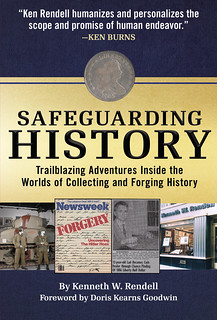 We talk about life, loss, famous hoaxes, and what makes all of us susceptible to being fooled by con artists.
We talk about life, loss, famous hoaxes, and what makes all of us susceptible to being fooled by con artists.
To access the podcast, see:
CoinWeek Podcast #183: Safeguarding History With Kenneth Rendell
(https://coinweek.com/coinweek-podcast-safeguarding-history-kenneth-rendell/)
CoinWeek Podcast Episode #183: Safeguarding History with Kenneth Rendell
(https://www.youtube.com/watch?v=ywRVYh1HHuE)
Also, Whitman Publisher Dennis Tucker posted this note on Facebook with a link to a new C-SPAN interview. -Editor
Kenneth W. Rendell's new memoir, "Safeguarding History," is available now. Coin collectors know Rendell as a contemporary of Q. David Bowers, Kenneth Bressett, Grover Criswell, Dick Johnson, and others who started the Rittenhouse Society in the 1950s, when Rendell was a prodigy teenaged coin dealer (selling to the likes of Ambassador and Mrs. R. Henry Norweb). Here's a C-SPAN "Booknotes+" interview that focuses on his life in the world of rare manuscripts and artifacts. The interview gets into Rendell's debunking of the Hitler Diaries, his appraisal of the Richard Nixon Watergate tapes and letters, his work building the massive personal library of Bill and Melinda Gates, the so-called "Jack the Ripper" diary, and more.
To watch the C-SPAN episode, see:
Booknotes+ Podcast: Kenneth Rendell, "Safeguarding History"
(https://www.youtube.com/watch?v=V_ofDU21XQc&t=14s)
To read the earlier E-Sylum articles, see:
NEW BOOK: SAFEGUARDING HISTORY
(https://www.coinbooks.org/v26/esylum_v26n31a06.html)
BOOK REVIEW: SAFEGUARDING HISTORY
(https://www.coinbooks.org/v26/esylum_v26n39a07.html)
BOOK REVIEW: SAFEGUARDING HISTORY
(https://www.coinbooks.org/v26/esylum_v26n40a07.html)
BURTON H. HOBSON (1933-2023)
Numismatic author Burton Hobson has passed. Sorry to hear the news. Pete Smith published an article about him last August - follow the link below for more information. -Editor
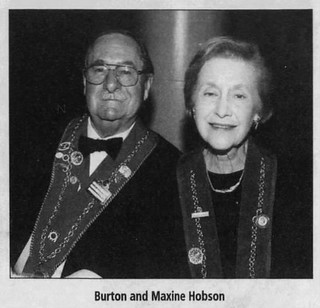 HOBSON--Burton Harold. 1933-2023. Burton Harold Hobson passed away on October 3, 2023, at the age of 90. He was born in 1933 in Galesburg, Illinois, and met his wife Maxine Meyer when they were both freshmen at the University of Chicago. After graduation he worked at Marshall Field & Company in Chicago, where he became manager of the coin and stamp department. While in that position, he wrote the first of his numerous books on coins, many of which have been translated into foreign languages. He won the Robert Friedberg Award for Numismatic Literature in 1972.
HOBSON--Burton Harold. 1933-2023. Burton Harold Hobson passed away on October 3, 2023, at the age of 90. He was born in 1933 in Galesburg, Illinois, and met his wife Maxine Meyer when they were both freshmen at the University of Chicago. After graduation he worked at Marshall Field & Company in Chicago, where he became manager of the coin and stamp department. While in that position, he wrote the first of his numerous books on coins, many of which have been translated into foreign languages. He won the Robert Friedberg Award for Numismatic Literature in 1972.
From there he became the Sales Manager for Sterling Publishing Company in New York. He worked his way up in the company, eventually becoming President and then Chairman of the Board. Under Burton's leadership, Sterling Publishing became best known for launching the Guinness Book of World Records as an international authority.
As a result of working with chefs and sommeliers on their books, Burton became very interested in the food and wine world. He became Bailli Delegue (National President) of the Confrerie de la Chaine des Rotisseurs, a Trustee of the Culinary Institute of America, and an Honorary Trustee of the American Academy of Chefs. He was made an Honorary Doctor of Humane Letters by Johnson and Wales University, and was a Trustee of the Wildlife Trust. Burton was also a member of the Confrerie des Chevaliers du Tastevin, Keepers of the Quaich, and the American Numismatic Society.
Burton was predeceased by his wife Maxine in 2019. He is survived by his three children, Alice Gansfield (Steven) of Boulder, CO, Andrew Hobson (Ginger) of Naples, FL, and Mark Hobson (Traecy) of Westfield, NJ. He also leaves behind grandchildren, Amanda and Ben, Sam, Adam, Jeremy, Christopher, Kevin and Jin, Jillian, and Ryan, and a great-granddaughter, Maxine.
To read the complete article, see:
BURTON HOBSON Obituary
(https://www.legacy.com/us/obituaries/nytimes/name/burton-hobson-obituary?id=53290113)
To read the earlier E-Sylum article, see:
BURTON HAROLD HOBSON
(https://www.coinbooks.org/v25/esylum_v25n32a21.html)
TIMOTHY HAROLD LAPOINTE (1947-2023)
E-Sylum Feature Writer and American Numismatic Biographies author Pete Smith submitted this article on the late Tim LaPointe. Thank you. -Editor
 The April death of Timothy LaPointe has gone mostly unnoticed in the numismatic media.
Although he was involved in what may have been the greatest scandal in numismatic history, his
contribution is little noted and not long remembered.
The April death of Timothy LaPointe has gone mostly unnoticed in the numismatic media.
Although he was involved in what may have been the greatest scandal in numismatic history, his
contribution is little noted and not long remembered.
Timothy LaPointe was born in Chicago on January 3, 1947. He was the son of Kenneth P. LaPointe and Edith C. LaPointe. In the 1950 census, Kenneth was listed working in an aircraft assembly plant in San Diego.
Timothy LaPointe graduated from Pierce College in Los Angeles with a degree in business.
He married Nancy M. Corbett in Los Angeles on September 13. 1969. The marriage lasted less than four years and ended in divorce in April 1973. He played semi-pro baseball and signed a contract with the California Angels.
He began working for Numismatic Funding Corporation (NFC) in 1973. There he implemented a successful inventory management system. After two years he moved to the wholesale arm of NFC, with Old Roman Coin Exchange in New York City. He attempted to go into business for himself, but lacked adequate capitalization to succeed.
Then in 1978 he joined New England Rare Coin Galleries as executive sales representative in the
wholesale department in Boston. He contributed a Market Report
to their Inventory Selections
publication. When the company became Heritage, he moved to Texas. In the 1980's he worked
for Numismatic Certification Institute.
In 1989 he became director of sales for the numismatic and collector investor division of Ruffco Financial Services in Provo, Utah.
In 1992 he was appointed executive vice president of Numismatic Investments of Ohio in Toledo. That firm was affiliated with Tom Noe and Vintage Coins and Collectibles in Maumee, Ohio. By 1998, Vintage Coins was nearly insolvent. Then the Ohio Bureau of Workers Compensation gave Tom Noe $25 million to go play in the coin market. He spread the money over several subsidiary companies. He also used money from the coin fund to pay off debts and to improve Florida property.
Occasionally auditors would stop by to see how the fund was doing. Based on glowing reports of success, he was given another $25 million in 2001. A 2006 audit was not so favorable. Ohio State Auditor Betty Montgomery reported that Noe owed the state 13.56 million dollars.
On February 13, 2006, Noe and Lapointe were indicted on charges of racketeering, theft, forgery and money laundering. At trial, LaPointe testified against his friend and former boss.
When inspectors were coming, they would borrow coins from customers and other dealers to create the appearance of coins in the fund inventory. LaPoint testified that he made up phony purchase orders to give the appearance that they owned the borrowed coins.
The company bookkeeper, Jeannie Beck, testified that the company borrowed money from the fund but recorded this as a purchase, as instructed by LaPointe. It appeared that the coin fund purchased coins from Vintage Coins. At other times, the fund wrote checks payable directly to Noe.
Priscilla Livingston, retail sales manager, reported that the store didn't make much money. She testified that LaPoint controlled the computerized inventory of the coin fund and told her what coins belonged to the store and what belonged to the fund. She was rewarded with a $10,000 bonus in 2004.
On November 27, 2006, LaPointe pleaded guilty to three counts of record tampering. On January 8. 2007, he was sentenced to three years in state prison. He served time at Ohio Hocking Correctional Facility.
There were two parts to the Coingate
scandal. It began with an investigation into illegal
campaign contributions from Noe. Charges were made against twenty-one people with nineteen
convicted including Ohio Governor Taft.
Mismanagement of the coin fund resulted in charges only for Noe and LaPointe. After all the assets were liquidated, the state recovered about $56 million from their $50 million investment. However, they lost out on interest that should have been earned by the investment.
After release from prison, Lapointe went to work for Casey Noxon with Texas Numismatic Investments Inc, (TNII) They attended the 2023 Central States show at Schaumberg, Illinois. After the show they got in the car to drive home. Noxon noticed that Lapointe appeared to be unconscious. He could not be revived.
LaPointe died on April 27, 2023. His obituary was published in The Blade on May 7, 2023. His
survivors include his wife, Beth, and sons Jason and Kyle. The obituary mentioned that he was
an athlete, a soldier, a leader, and a provider.
It makes no mention of his profession.
The obituary can be found at https://www.legacy.com/us/obituaries/toledoblade/name/tim- lapointe-obituary?id=51802710
NNP ADDS COINAGE OF EL PERÚ SLIDE SET
The latest addition to the Newman Numismatic Portal is the ANS Coinage of El Perú slide set. Project Coordinator Len Augsburger provided the following report. -Editor
Coinage of El Perú Slide Set Digitized by Newman Portal
In 1988, the ANS Coinage of Americas Conference focused on Peruvian coinage, and a slide set produced in conjunction with this conference has recently been digitized. This particular set, loaned by Wayne Homren, seems none the worse for wear, and the color images exhibit strong clarity despite the passage of time. The slides are keyed to a booklet authored by Freeman Craig, Coinage of El Perú, which has also been scanned. Illustrated here is a Lima 1-real (1568-1570).
I'm glad this worked out. ANS publications are top-notch, and now more people can enjoy the scholarship. -Editor
Link to Coinage of El Perú slide set on Newman Portal: :
https://nnp.wustl.edu/library/imagecollection/517650
Link to Coinage of El Perú, by Freeman Craig:
https://nnp.wustl.edu/library/booksbyauthor/551463
Link to Coinage of Americas Conference proceedings:
https://nnp.wustl.edu/library/publisherdetail/510766
VIDEO: COLLECTING BARBER COINAGE
The David Lisot Video Library on the Newman Numismatic Portal can be found at:
https://nnp.wustl.edu/library/multimediadetail/522852
We highlight one of his videos each week in The E-Sylum. Here's one from 2017 with John Frost speaking about Barber coinage. -Editor
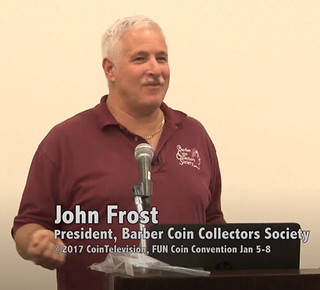 Mr. Frost is the current president of the Barber Coin Collectors Society. He's also the editor of the society's journal. Mr. Frost will provide a fascinating overview of Barber coinage, along with a commentary on the do's and don'ts of collecting these coins. Speaker: John Frost. Running time: 53:21.
Mr. Frost is the current president of the Barber Coin Collectors Society. He's also the editor of the society's journal. Mr. Frost will provide a fascinating overview of Barber coinage, along with a commentary on the do's and don'ts of collecting these coins. Speaker: John Frost. Running time: 53:21.
To watch the complete video, see:
https://nnp.wustl.edu/library/book/540301
POBJOY MINT TO CLOSE
I couldn't find anything on the company's website, but a Numismatic News article cites a CoinWorld podcast interview announcement that the Pobjoy Mint will close at the end of 2023. -Editor
 It is with great sadness that Managing Director Taya Pobjoy has announced her official retirement and the closure of Pobjoy Mint after 58 years of manufacturing official currency and commemorative coins. The Mint closure will take place at the end of 2023, so customers will have a chance to complete their collections for the full year, with some releases being brought forward to allow plenty of time for collectors to buy them.
It is with great sadness that Managing Director Taya Pobjoy has announced her official retirement and the closure of Pobjoy Mint after 58 years of manufacturing official currency and commemorative coins. The Mint closure will take place at the end of 2023, so customers will have a chance to complete their collections for the full year, with some releases being brought forward to allow plenty of time for collectors to buy them.
Since its establishment in 1965, the private mint in Kingswood, Surrey, England, some twenty miles outside of London, has produced coins for forty-two nations and territories. Since the mint first entered the market in 1965 with medals commemorating Winston Churchill's passing, it has produced a variety of circulation coins, medals, and commemorative coins. Approximately 40 employees will be affected.
"I've made the big decision to retire this year. My prime objective is to give the customers our service until the end and to make sure that they get a complete year because we all know that coin collecting is an annual thing with a date change. So it's been very much on my mind when making this decision to make sure I give a good service to the very end to my customers..." - Taya Pobjoy
Here's some additional background on the company from the firm's website. -Editor
Set up by the Pobjoy family in 1965, Pobjoy Mint is a manufacturer of legal tender coins for over ten British Overseas Territories. As a private mint, we also produce medals, medallions, official regalia, tokens and numismatic gifts.
We strike official commemorative and circulating coins, therefore, all our coins bear HM King Charles III's effigy, the Late Queen Elizabeth II's effigy or the Coat of Arms of the country.
Pobjoy Mint UK headquarters and factory are based in the county of Surrey, England. Since 1996, we also have an office located in Minnesota, United States of America.
Our UK office serves clients across Europe, Africa, Asia, Australia and Antarctica whilst the USA office serves clients across North and South America.
So what's next? Will the British seek bidders to take over the business of making NCLT for the overseas territories? -Editor
To read the complete article, see:
image caption
Pobjoy Mint Announces Retirement of Managing Director, Taya Pobjoy, and Mint Closure
(https://www.numismaticnews.net/world-coins/pobjoy-mint-announces-retirement-of-managing-director-taya-pobjoy-and-mint-closure)
To listen to the podcast, see:
Episode 221: The Pobjoy Mint Makes a Big Announcement
(https://open.spotify.com/episode/78Dg5PhjlqOfN17YTkNp7n?si=b8sm5b6OTMKyZLeKn_eYzw&nd=1)
https://www.coinworld.com/coinworld-podcast
NOTES FROM E-SYLUM READERS: OCTOBER 15, 2023
We Shall Persevere
Last week I asked about the "We Shall Persevere" motto on the 2023 American Liberty silver medal' -Editor
"I have not found a statement from the Mint indicating the source.
"Mr. Google says the quote is from CAA Savastano. We shall persevere because we must.
Mr.Google does not cite a specific source.
We shall persevere
was used in a 1997 episode of South Park.
"The Newman Numismatic Portal shows only one usage. That was from a 1969 report from the Secretary of the Treasury. (You can look it up)
"Then there was John Cotton Smith who wrote this in 1812."
Thanks. "We Shall Persevere" makes a great motto. Here's a great Washington Post article about a family's perseverence following a tragedy. -Editor
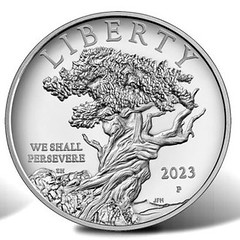 My limbs still carry memories of my former life, the one snatched from me, the one that suddenly turned nightmarish with screams and cries and regret for our little girls.
My limbs still carry memories of my former life, the one snatched from me, the one that suddenly turned nightmarish with screams and cries and regret for our little girls.
But what choice do I — really all of us — have but to persevere? To take the call knowing it might be news of a death or a voice from Stockholm.
To read the complete article, see:
Our lives had been shattered. Now something extraordinary was happening
(https://www.washingtonpost.com/wellness/2023/10/14/grief-healing-families-joy/)
To read the earlier E-Sylum article, see:
NOTES FROM E-SYLUM READERS: OCTOBER 8, 2023: Query: We Shall Persevere
(https://www.coinbooks.org/v26/esylum_v26n41a14.html)
On the Value of Union and Confederate Currency
Heidi Dehn writes:
"I received your contact information from the Massachusetts Historical Society after contacting them about the value of currency for the Union and Confederacy. I am writing a story set in December of 1864 in Texas. I am wanting to incorporate accurate information regarding the cost of goods and services during this time, such as the price of a gallon of milk, a pound of flour, and the cost of a train ticket to travel approximately 300 miles. I am also interested in the difference between the value of currency between the Union and the Confederacy. For instance how much did a loaf of bread or a ton of coal cost in the Union vs. the Confederacy.
"Thank you for any help you can provide in this regard!"
My interest in Civil War numismatics was as a collector, and I wasn't able to address her questions about the economics. I did reach out to economist JP Koning, who offered to check his references to see if he could help. Thank you. Can any of our readers assist? -Editor
Review: The Economy of Colonial America
On a related note, over on the Colonial Coins mailing list, people were discussing a book about a similar topic in the colonial era. -Editor
"I recently finished a book that was recommended on this group: The Economy of Colonial America,
(2nd Ed.) by Edwin J. Perkins. It was extremely interesting and helpful to anyone who wants a greater understanding of pre-federal life and times, and provided me with important context for the coins and currency that we collect. Especially interesting was the chapter on Money and Taxes,
pp.161-183, which talks about the availability of specie and discusses the role of paper money in some detail. I would recommend the book to further an understanding of colonial monetary life. Thanks to whomever mentioned the book on this group."
Jeff Rock writes:
"I also recommend John McCusker's book on the subject, which is used more for college level courses but still a fascinating read."
On Dealer Ethics
Regarding ethical questions raised by the Fang mask sale,
Keith Scott of
Milpitas CA writes:
"About 8 to 12 years ago there was a trend of buying sprees of Dealers who set up at local hotels and take out 1 or 2 page ads in the local paper and sometimes radio ads. Diamonds, gold, coins, watches, and currency that were just gathering dust was what was wanted.
"I conducted a test in which two coins (a 1854 J160 pattern cent, Pf 63, and a 1872CC 50C, AU) were placed in OLD envelopes and taken to the event. The first one yielded an offer of about 5 cents on the dollar. The second about two years later yielded an offer of about 8 cents on the dollar. Coins used this time were pattern dimes in OGH and PF 64 and 65.
"Both dealers were members of the ANA, PNG, and most other organizations. Each story was shared with fellow coin club members.
"I'm not a Dealer and prefer the acquisition process. Seller beware."
Scott Semens writes:
"Just before reading that piece in E-Sylum, I was watching the Album book sale mentioned in the same issue, lot by lot, as snipers chased the popular titles with last minute bids. A few obscure titles languishing at my website went for multiples of what I am asking for them, while others brought less than my cost from the publisher. How crazy auctions can be! I think this may be another example of the same phenomenon.
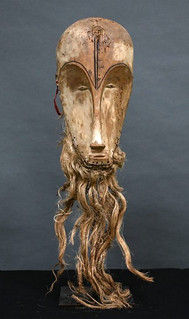 "I have some slight experience with selling African masks, and recognized the elongated Fang style from the modern versions I had sold. The estimate range of Eu100-600 the lucky dealer received across two auction firms sounds about right, maybe high on the Eu600. I can see no rational reason why such a mask, or in fact any African mask, would ultimately go for Eu4.4 million. Maybe there is some grisly ritual involved, or the provenance was important. The point is, absolutely nobody could have seen this coming. Clearly the dealer was not cheating the seller when he originally bought it cheaply then set out to research it, though I can understand the chagrin of the heirs when they found out what it went for.
"I have some slight experience with selling African masks, and recognized the elongated Fang style from the modern versions I had sold. The estimate range of Eu100-600 the lucky dealer received across two auction firms sounds about right, maybe high on the Eu600. I can see no rational reason why such a mask, or in fact any African mask, would ultimately go for Eu4.4 million. Maybe there is some grisly ritual involved, or the provenance was important. The point is, absolutely nobody could have seen this coming. Clearly the dealer was not cheating the seller when he originally bought it cheaply then set out to research it, though I can understand the chagrin of the heirs when they found out what it went for.
"I agree the dealer was being generous when he offered to rebate the sellers a significant sum in retrospect. What we are not seeing here are the objects this dealer bought over the years in good faith and later found out were forgeries, or not worth what he paid, just like the book titles a dealer has to sell at a loss because a subsequent publication or other factors reduce the value. Dealers have to work on the averages. Be happy when a rip
comes along to balance out the losses."
To read the earlier E-Sylum article, see:
FRENCH COUPLE SUES DEALER
(https://www.coinbooks.org/v26/esylum_v26n41a30.html)
On the Numismatic Proof Scale
Bill Groom writes:
"I much appreciated Jerry Nashorn's comments on the Proof Scale. I feel it's an important component in the counterstamp database I built. I'm hopeful that this database may eventually be made available to collectors, via the NNP. It's a useful tool, given the many probable and "slam-dunk" positive attributions I've been able to make over many years now. I'm constantly updating it as I gather new info. Another benefit is that reports can be generated to show trends relative to locations, host coins, occupations, dates, populations, etc. There's a great deal to as yet be studied and learned about this practice.
"On another note, Jerry wrote that, " .... his (my) approach seems to be to buy the coin first and then do the research." For the record, my approach is completely the opposite. I always try to do the research BEFORE making a purchase. Back in the eighties and nineties, I had no internet to do research. All I had were the public libraries and the Brunk/Rulau books which had many unfounded attributions. As Philadelphia was a hub of c/s activity, I once spent a week in the library there, looking at microfilm and early directories. I did likewise in Chicago for a week; these, among other northeast locations. Study is essential for proper attribution.
"Back then, I winged it at shows, occasionally buying lot groups. Given time constraints, doing research on these purchases wasn't possible. I had to go on intuition and "my eye" for spotting attributable c/s's. Nowadays, with eBay and other auctions, there's plenty of time to study the c/s's. Some of the bigger auction houses sell lots that consist of groups of c/s's. Of course, if there's a good one or two c/s's in a single lot, I've been obliged to buy it as such. Like Jerry and other serious numismatists, I do try to be discriminating in my purchases, circumstances permitting.
"Many collectors, especially those who are keenly condition-conscious, liken the counterstamping of coins to a crime. Along that line, I've adopted the attitude of a crime-solver, a detective. I study the evidence at hand. Some is circumstantial like the size and style of the stampings, peculiarities like the use of stops or periods. the positioning of the stamping, etc. These forensic aspects offer clues, positive and/or circumstantial. Some of my best attributions have been made with naught but a single surname as evidence. For collectors who relish thinking out-of-the-box, studying counterstamps can be a fun and challenging pursuit."
I agree! I collected these for years and had great fun acquiring them. Research is somewhat easier these days with internet sources, especially newspaper archives. -Editor
To read the earlier E-Sylum article, see:
THE NUMISMATIC PROOF SCALE
(https://www.coinbooks.org/v26/esylum_v26n41a12.html)
HEARTLAND CSNA EDUCATIONAL SYMPOSIUM
The Heartland Coin Club show in Santee, CA on October 28, 2023 will feature an Educational Symposium in cooperation with the California State Numismatic Association. -Editor
The California State Numismatic Association is delighted to host three distinguished guest speakers. The presentations will be held in the Small Hall, which is located next to Cunnane Hall. These talks are complementary and open to everyone.
12:00-p.m.
Richard Dowis: Collecting NASA and Apollo Memorabilia and Coins
Dick, of the Hemet Coin Club, will be doing a presentation on his outstanding collection of NASA/Apollo related memorabilia. Dick has amassed a large number of collectible items and commemorative coins related to the space program and its achievements and will have a number of items on display!
1:30-p.m.
Dr. Robert Fagaly: Comitia Americana Medals, their Creation and History
Dr. Fagaly, Ph.D. in Physics, was the lead author for the Grading Guide for Early American Copper Coins
, which was awarded the NLG's Book of the Year in 2015. His current interest is in the Comitia Americana medals, the subject of his presentation. The Comitia Americana Medals series, produced between 1776 and the early 19th century, memorializes some of the pivotal moments of the American Revolutionary War and were created after Continental Congressional voted to memorialize the heroism, friendship, and leadership of key American and French revolutionaries. Dr. Fagaly has graciously volunteered to display his personal collection of these extremely rare medals as part of his presentation.
3:00-p.m.
Jim Phillips: How to Create and Maintain a Website for Your Club.
In this age of electronic information, a basic website with information about your club is almost a necessity, and with today's design programs they are easier than ever to create! Jim will go over the basics and show how to design, and put on-line, a simple and maintainable website for your club. It really is doable and is one of the things most needed by clubs to communicate to their members and public.
Admission is FREE.
Here's some additional information on the show. -Editor
Spend a delightful Saturday immersing yourself in the fascinating world of coin collecting. Whether you're a novice looking to start your own collection or an experienced collector seeking to expand, you'll find a wide selection of collectible coins from the U.S. and abroad, as well as antique coins and paper money. Remember, there's no pressure to buy anything! Dealers will be present to buy, sell, and offer appraisals. We warmly invite you, your family, and your friends to join us for a day filled with enjoyment and education at our Coin Show.
- The event will take place on Saturday, October 28, 2023.
- It will start at 10:00 a.m. and end at 4:00 p.m.
- The venue is the Cunnane Social Center at Guardian Angels Catholic Church, located at 9310 Dalehurst Rd., Santee, CA.
-
The admission fee is $3.00, but there are several exceptions:
- Admission is free for Heartland Coin Club Members.
- Members of any of the San Diego County Coin Clubs can enter for free.
- California State Numismatic Association (CSNA) members are also granted free admission.
- Children under 16, when accompanied by an adult, and Boy Scouts and Girl Scouts in uniform, can enter for free.
- All veterans and active military personnel (with military ID or another form of military service credential) are admitted for free.
For more information, see:
http://www.heartlandcoinclub.com/coinshow.html
THE BOOK BAZARRE
How fortunate is it to gain intimate access to the complicated life of one of our greatest collectors of historical artifacts. Ken Rendell courageously shares the triumphs and tragedies of his life. Bravo.Order your copy online (including at Whitman.com ), or call 1-800-546-2995.
VOCABULARY TERM: OPEN FACE DIE
Here's another entry from Dick Johnson's Encyclopedia of Coin and Medal Terminology. -Editor
Open Face Die. A striking die used without collar or restraining ring. Open face dies are suitable for multiple striking and are shaped like the diestock from which they are cut, their image being engraved into the smoothed flat top of the diestock cut to proper size; the image occupies the central portion of the die's top surface with a wide margin surrounding the design.
Extremely versatile, open face dies can easily be used in most medal presses, and are adequate for all size struck medals one-half inch and larger; they are particularly advantageous for all medals too large to be coined – over 2 ? inches in diameter – up to struck medallions six inches in diameter. They cannot be used for coins.
History. Open face dies came into use during the French development of the art medal in the 1880s. They were the direct result of larger and stronger presses that could accommodate the striking of larger pieces. Open face dies allowed large medals to be struck rather than cast for the first time in substantial production runs.
Thus the acceptance of open face dies spread to countries with active medal plants and their use was universal by the first decade of the 20th century. This important development of a large size striking die – along with the reducing pantograph from oversize modeled relief sculpture for the medal design – were the three major factors leading to the modern art medal.
Open face versus collar dies. All dies are made for a specific striking process. The process determines the kind of press and the press determines the kind of die. Open face dies are in contrast to collar dies (also called coining dies) that are machined to the requirements of the coining press and the use of the collar. There is no margin on a coining die, its striking surface is at the end of a long neck that fits within the opening of the collar.
The circumference of the coining die – nearly the same as the diameter of the struck piece – must be machined within hundredths of an inch smaller than the aperture in the collar. Obverse and reverse dies must enter this aperture – called the coining chamber – strike a blank and retract from this opening.
Open face die characteristics. In contrast, open face dies have no collar, do not have to enter an aperture or opening and have no neck or shoulder; they are not machined to a silhouette to accomplish what coining dies have to accomplish. Open face dies have a flat surface at the top of the die – the design is sunken into this flat top surface within a wide margin.
Open face dies take the shape of the diestock from which they are made, and since most diestock is circular most dies are circular (but diestock and dies can be square, rectangular or even hexagonal). Large open face dies look like small round hat boxes and are, indeed, called box dies in England.
Open face dies are usually twice the diameter of the struck pieces from that die (see chart, Typical Die Diameters). The greater diameter provides greater mass to the die to enable it to strike very large medals (up to six- inch diameter), very heavy thickness in relief or gauge –all under very high pressure. Without such additional mass the dies would not have the strength to do this nor sustain long production runs.
Despite the fact open face dies cannot be used in coining presses, they may, however, be used on a variety of striking presses. This includes hydraulic, knuckle-joint and some punch presses.
Also all coined pieces are usually mechanically fed (obviously all high-speed coining is mechanically fed); all pieces struck from open face dies must be hand fed. Coining is high speed; striking with open face dies is much slower, where a manual operator feeds and ejects struck pieces in synchronization with the cycle of the press.
As a final point of comparison between open face and collar dies, coining requires a pre formed (upset) blank. A blank for open face dies need only be the proper gauge but can be the same size – or somewhat larger – than the intended struck piece. All pieces struck from open face dies must be trimmed.
How open face dies are made. The diemaker must know the process for which a pair of dies are intended, he receives a work order which states the type of press and a diameter to cut the dies. He is also furnished a metal or epoxy pattern (dieshell) from which to cut the die. He will mount the pattern dieshell in the die-engraving pantograph and mount a proper diameter diestock. For an open face die he must choose a diestock wider than the intended diameter of the medal is chosen.
The pantograph is set to tracing the relief of the pattern, and by means of a long bar this is transferred to the cutting point which mills (cuts) the rises and falls of the relief into to center of the steel diestock. This continues for the full diameter of the pattern, reducing the design in the prescribed ratio to cut the exact diameter required in the diestock. Usually three separate cuts are made to ensure all cavities of the relief pattern are cut into the die. See pantograph.
Open face dies, while they could be handcut, are almost always cut by pantographic reduction. Thus highly detailed designs can be mechanically cut with an assurance of close fidelity to the original design. After the final cut, the die is examined, proved by taking a lead impression, and if satisfactory, the die is hardened by tempering.
Nothing more is done to the die. It is not trimmed to a silhouette to fit a collar as a coining die. It is ready for striking after it has been hardened and normalized. See heat treating.
Orientating open face dies. Once the dies have been inspected, approved, hardened and before they go on a press they can be marked in some way so they line up, so the die alignment of pieces stuck from those dies will have a perfect orientation of their obverse and reverse axis. This can be done in several ways.
For dies that are cut from bar stock they will be round in circumference. Orientating a die is to twist it slightly. They can be scribed or marked or painted on the side to indicate that the 12 o'clock position of one will match the 12 o'
clock position on the other. The mark, obviously, must be in a position it can be viewed when it is set in a press.
If the orientation is super critical a mechanical device can be created with the pair of open face dies. In the margin on the face of one die – outside the image area of course – can be located a bushing, a hole drilled right into the top margin surface of the die. Into this bushing will be inserted the guide pin. Another hole is drilled into the opposite die in exactly the corresponding position.
This technique, called guide pin and bushing, can be used while the press operates, or if necessary, the guide pin may be removed. Only on open face dies can a guide pin and two bushings be used because of the margin on the face of both dies.
Resulting edges on pieces struck from open face dies. Because there is nothing to restrain the flow of metal when blanks are struck between open face dies, metal extrudes from the edge between the dies. This flange – called flash – grows larger during multiple striking. After the metal is fully struck up this flash is trimmed off. Large round medals can be easily turned on a lathe (with the use of a form mold). Irregularly shaped medals must be trimmed by hand or require a trimming tool (with trimming punch and plate).
For those medals trimmed on a lathe, tool marks, called annular rings, are often seen on the edge running parallel with the sides of the medal. Thus this type of trimming and these marks are diagnostic evidence these pieces were struck with open face dies.
Collars for large medals were used in the 19th century were virtually eliminated by the first decade of the 20th century. Open face dies are now universally used for striking all large medals.
Storage of open face dies. Open face dies have an inherent characteristic – they almost never wear out (their die life is greater than most intended use). Thus dies are excellent for such medal programs that require medals over long periods of time.
Such dies are placed in a DIE VAULT for storage. They must be treated to prevent rusting and stored in a dehumidified atmosphere. The face of the die must be protected from rusting, if possible it must be kept without exposure to air. This is done by storing with a struck specimen between the dies – one on top of the other – or by placing Cosmolene, petroleum jelly or a plastic cap over the face, and storing these side by side. The intent here is to prevent moisture from reaching the face of any die.
See the next article in this issue for more information on dies and collars. -Editor
To read the complete entry on the Newman Numismatic Portal, see:
Open Face Die
(https://nnp.wustl.edu/library/dictionarydetail/516424)
EDGE COLLARS
In a CoinWeek article published this week, Roger Burdette takes a detailed look at edge collars and designs on a coin's edge. Here's an excerpt - see the complete article online for more, -Editor
All United States coins have three sides. Collectors pay most of their attention to the obverse (the front or portrait
side), and the reverse (the back or denomination
side). Those are where the meat
of a coin – its design, date, denomination, mintmark, and so forth – are found. But the edge also includes interesting information, and in some cases, what's on the edge can make a huge difference in desirability.
An edge collar
or edge die
is a steel disc about five to 10 millimeters thick, 100 mm in diameter, with a circular hole cut in the center. For plain edge coins, or those with incuse ornaments, this hole is the exact diameter of the finished coin. If a coin has a reeded edge, then the hole's diameter is that of a finished coin less the depth of the reeds. In this way the completed coin has its correct diameter when measured over the reeds. A similar approach is used when a design has raised ornaments on the edge.
There are three basic types of edge dies, or collars, that were used by the United States Mint: open, close, and segmented. All three collar types were supported in the press by heavy springs. This allowed the collar to move downward if it were accidentally struck by the hammer die or when a planchet did not seat fully in the collar.
An open collar was used for most U.S. coin denominations from 1792 through part of 1828. This was followed for smaller diameter coins with a close collar in 1829, then larger coins, and finally, a segmented collar for eagles and double eagles, beginning with the Saint-Gaudens designs of 1907-1933.
To read the complete article, see:
Edge Collars – Coining's Third Dimension
(https://coinweek.com/edge-collars-coinings-third-dimension/)
RON GILLIO INTERVIEW, PART TWO
Greg Bennick's latest interview for the Newman Numismatic Portal is with longtime dealer Ron Gillio. Here's the second of five parts, where Ron discusses his first coin shop, and working with Walter Breen. -Editor
GREG BENNICK: For sure. Now, when did you open your first shop? Did you open a first shop around that time? I mean, how old were you at this point?
 RON GILLIO: Well, I was 1963-64, I was 17-18 years old. I just advertised in the
Scrapbook and the Numismatist at the time. Didn't really have a shop. When I
graduated from high school, I opened a shop in Van Nuys, California. I opened the
shop in 1966. So, it was two years after I graduated from high school. The thing that
I did get involved in 1967, I got involved in the silver certificates.
RON GILLIO: Well, I was 1963-64, I was 17-18 years old. I just advertised in the
Scrapbook and the Numismatist at the time. Didn't really have a shop. When I
graduated from high school, I opened a shop in Van Nuys, California. I opened the
shop in 1966. So, it was two years after I graduated from high school. The thing that
I did get involved in 1967, I got involved in the silver certificates.
GREG BENNICK: Tell me more about that. Yeah, I'd like to hear about that.
RON GILLIO: Yeah. Well, at the time, I opened the office, but I still worked. I worked at General Motors assembly plant. My uncles worked there. My father worked there. So, I had a job there. And I was buying silver certificates during the day, working at night at General Motors. And then I had this job where I got a promotion and I had an offline job. So, I had extra time. So, I decided that I would tell the guys who worked that I was buying these silver certificates. So, during my work time, I would buy silver certificates from them and I would buy them during the day from coin dealers. And then I would take a couple of days off and go up to the San Francisco Mint and cash them in for the silver. And then sell the silver to a guy that was a coin dealer in San Francisco, Wayne Portelli, great guy. He's retired now, living in Mexico. But that was a great experience buying the silver certificates and cashing them in. So, I did that at the same time, but I was making more money in a week than I was making in six months working. So, I told my father I was going to quit. He didn't want me to quit, but I convinced them that I'm going to do it anyways. And I quit my job and I just went full-time into the coin business at that time and then going to coin shows and just kept going.
GREG BENNICK: Now, at this point, was this around the time or just before you opened Western Coin and Antiques? Was that around the same time?
RON GILLIO: No, it's not. What happened was, is to give you a little bit more of what I did in the 60s. I was still in the San Fernando, Van Nuys. I had the office there. I was going to coin shows. I actually ran a little coin show and an auction with a coin dealer at the time named Paul Copenhaver. He and I had an auction company. We ran auctions 1967-68 in the San Fernando Valley. And then I decided that I wanted to move out of the LA area. So, I used to go to Santa Barbara a lot in the 60s. So, in 1970, I moved to Santa Barbara and opened a store in Santa Barbara, but at the same time, kept the office in Van Nuys. Oh, and what I haven't mentioned yet, there's so many little things that I did during that time. I also formed this American Institute of Professional Numismatists. I hired Walter Breen to write a book, How Coins Are Made and Mismade. And I had an office in Beverly Hills for the Institute, which was just a mailbox. It was not a mailbox. It was a building. It was 435 North Roxbury in Beverly Hills, where I'd go pick up my orders for the book that Walter wrote. And at the end of the course, the book, we would have a test. And I would actually give people that did it diplomas.
GREG BENNICK: So, the book was like a workbook of sorts, like it was a workbook or a course of some kind?
RON GILLIO: It was a course on how coins were made and mismade. At the same time, I ran that, I closed my office in Van Nuys, opened the store, Western Coin Antiques in 1970 in Santa Barbara.
GREG BENNICK: So, what was it like working with Walter Breen on this project? I mean, Breen at the time was already quite well-known. So, I mean, that must have been a pretty exciting time to work with him on that book. I've not seen a copy of that. I wonder if there are any existing in the world somewhere.
RON GILLIO: There are. There's been a couple of, I mean, I still have a couple of copies, but they're still around. They come up every once in a while. Somebody will send me a picture of this book. We found this book. Do you remember doing it? Tell us a little bit more about it. Actually, the E-Sylum, they had an inquiry about it. So, I did a little blurb on it for them one time. And it was fun working with Walter. That was my first experience with Walter in the 1970s. We did things later together, like the California Fractional Gold book, but he was very interesting. At that time, Walter, he was the main figure at a coin show, writing letters to people, authenticating their coins and writing them a letter. At the time, there was no grading services or certification services. So, he was kind of it. So, he was an interesting character, to say the least. And at that same period of time, from 63 to 71 and continuing on, I went to San Francisco a lot. So, I had occasions to visit Walter in Berkeley, where he lived. And he was quite interesting of a character. Then we did the California Fractional Gold book in 1983.
GREG BENNICK: As I understood it, he had a photographic memory for coins, like literally remembered every coin he saw, as the legend goes.
RON GILLIO: Oh, yeah. He was amazing. He could remember everything, every little detail.
GREG BENNICK: Wow. Now, how many people do you think passed the course and got your diploma? I need to go find some of these graduates someday.
RON GILLIO: How many people passed the course; I would say that there was at least a thousand people. Yeah. I mean, the course was $10. I mean, I'd go to the Beverly Hills. I live in the San Fernando Valley. I'd go to Beverly Hills, go there, get the checks, put them in the mail, send out the catalog. Some people would correspond with me. And then when they sent in the tests in the back, Walter had an answer. We used his answers, naturally. So, there was a lot of people that didn't pass the test. But many did. I would say close to a thousand.
GREG BENNICK: Amazing. It's almost like your own college, essentially.
RON GILLIO: Yeah, it was. It was interesting.
GREG BENNICK: Very much so.
RON GILLIO: One of the things I did in my career.
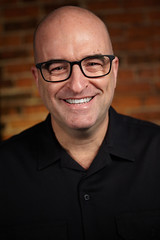 About the Interviewer
About the Interviewer
Greg Bennick (www.gregbennick.com) is a keynote speaker and long time coin collector with a focus on major mint error coins. Have ideas for other interviewees? Contact him anytime on the web or via instagram @minterrors.
To watch the complete video, see:
Ron Gillio Interview
(https://archive.org/details/rongilliointerviewvideo)
To read the complete transcript, see:
Ron Gillio Interview (Transcript)
(https://archive.org/details/gilliointerviewtranscript2)
To read the earlier E-Sylum article, see:
RON GILLIO INTERVIEW, PART ONE
(https://www.coinbooks.org/v26/esylum_v26n41a11.html)
NGC INTERVIEW: DON EVERHART
On their website, NGC published a nice interview with retired U.S. Mint sculptor Don Everhart. Here's an excerpt - see the complete article online. -Editor
Everhart was employed by the US Mint from 2004 to July 2017, when he retired as lead sculptor. Everhart has been involved in the creation of hundreds of coins, including some of the most memorable US Mint issues of the last decade including the distinctive eagle design that he engraved for the reverse of the 2015-W American Liberty High Relief $100 and the 2016 American Liberty Silver Medals.
Did you ever think you would become a coin designer and sculptor?
Not once. I thought I would be an illustrator of album covers in New York. This was totally serendipitous when I took off from work and went down there. My whole career path changed completely. It was a crossroads in my career, and I didn't really realize it at the time until I looked back at it and recognized that's where I branched off and really got into coins.
What was your inspiration when designing the March of Dimes coin?
In the case of the March of Dimes, I felt that the subject matter had to relay what their ultimate drive was, which is protecting the young. So, I was racking my brain at the Mint one day trying to figure out how I'm going to solve this problem.
I was working on it for hours and then this idea flashed in my head. My daughter is a professional photographer, and when she had her second child, she took the baby home and took a picture of the child with her husband's hand. The baby didn't take up much more than that hand, and it was sleeping.
I thought it was a great image because it conveys that the child is dependent on his parents for everything. I thought it really described the role of March of Dimes very well. Interesting thing about it, it was a family effort. You had me, the sculptor, working off the design from my daughter's photograph showing her husband holding her son. So, it was four of us in the same family that helped produce the idea for the coin.
To read the complete article, see:
NGC Signer Spotlight: Don Everhart
(https://www.ngccoin.com/news/article/12161/signer-spotlight-ngc-don-everhart/)
To read earlier E-Sylum articles, see:
DON EVERHART AT THE U.S. MINT
(https://www.coinbooks.org/v21/esylum_v21n16a10.html)
WEST POINT STRIKES MARCH OF DIMES SILVER DOLLAR
(https://www.coinbooks.org/esylum_v18n11a14.html)
WBNA US CURRENCY SALE FOUR
The World Banknote Auctions U.S. Currency Sale Four will close next week. The sale features a large selection ranging from Colonial, Fractional, Large Size, Nationals, Small Size, error, and Test notes. Highlights include a phenomenal 66 PPQ Ace on the Moniteau National Bank of California (MO), a couple of lovely Lazy Deuces, a beautiful uncirculated $10 Legal Tender Rainbow Note, a couple of high-grade early North Dakota nationals, a nice selection of about 50 Confederate notes, and a dozen error notes. Here are some selections. -Editor
Lot 4002: New Jersey March 25, 1776 Fr. NJ-183 PMG About UNC 53 EPQ 6 Pounds
This is the highest denomination of the March 25, 1776 issue of New Jersey that had an issuance of just 3,125 notes. Printed in three colors and one of the better produced Colonial notes, with a nicely contrasting design. We see a single centerfold but no heavy signs of circulation with clear signatures and strong originality. A scarce issue from the Colonial War period.
To read the complete lot description, see:
New Jersey March 25, 1776 Fr. NJ-183 PMG About UNC 53 EPQ 6 Pounds
(https://bid.worldbanknoteauctions.com/lots/view/4-BBLWP9/new-jersey-march-25-1776-fr-nj-183-pmg-about-unc-53-epq-6-pounds)
Lot 4035: Confederate States 1861 T-15 PCGS Very Fine 25 50 Dollars.
PF-1, CR-79. CC Cancelled. Often considered one of the Confederate's best designed notes, the Southern Bank Note Company produced only 14,680 of the notes. The central vignette of a wood burning locomotive as signified by its diamond stack is flanked by Justice at right and Ceres at left. This note hosts a penned radar serial number and is a desirable VF grade perfect for a seasoned collector.
To read the complete lot description, see:
Confederate States 1861 T-15 PCGS Very Fine 25 50 Dollars
(https://bid.worldbanknoteauctions.com/lots/view/4-BBLWR3/confederate-states-1861-t-15-pcgs-very-fine-25-50-dollars)
Lot 4065: Confederate States 1862 T-50 PCGS UNC 62 PPQ 50 Dollars
PF-4, CR-351. Horizontal CSA watermark. Crosscut Cancel. A lovely high grade original example that just has a crosscut cancel which is barely noticeable in the PCGS holder. A strong impression with good eye-appeal.
To read the complete lot description, see:
Confederate States 1862 T-50 PCGS UNC 62 PPQ 50 Dollars
(https://bid.worldbanknoteauctions.com/lots/view/4-BBLWSR/confederate-states-1862-t-50-pcgs-unc-62-ppq-50-dollars)
Lot 4102: Lowell, MA 1875 Fr. 391 The Wamesit NB CH# 781 PMG Choice Fine 15 2 Dollars
A lovely note from the birthplace of America's Industrial Revolution. The Wamesit National Bank organized in 1865 and lasted until 1927 when it merged with its crosstown rival of the Union National Bank of Lowell. This Lazy Deuce with strong penned signatures is the better of only two Lazy Deuces known on this bank. Its lower grade sibling last appeared in auction five years ago with this better note appearing for the first time in over two decades. This is a great opportunity for a special type note from Middlesex County with a Native American title.
To read the complete lot description, see:
Lowell, MA 1875 Fr. 391 The Wamesit NB CH# 781 PMG Choice Fine 15 2 Dollars
(https://bid.worldbanknoteauctions.com/lots/view/4-BBLWUT/lowell-ma-1875-fr-391-the-wamesit-nb-ch-781-pmg-choice-fine-15-2-dollars)
Lot 4108: California, MO Fr. 382 The Moniteau NB CH# 1712 PCGS Gem UNC 66 PPQ 1 Dollar
A lovely note that is surely among the highlights of this sale. While some of bigger banks had enough of an output to have a few original series notes saved in higher grades, along with perhaps a few serial number 1's, as a whole this is a very scarce type to find at the Gem Uncirculated level no matter where it's from. Luckily for collectors of the finest notes the supply also includes a small number of notes that came from the Moniteau National Bank of California, Missouri, which includes the Gem Uncirculated note offered here. Fantastic originality and eye-appeal are seen, with bold pen signatures, pleasing margins and a bright red overprint. This note is surely on the wishlist of many collectors, and it can fit right into many collections, from type sets to advanced Missouri collections. We must note that the other PCGS 66 PPQ Ace from here realized $15,600 at auction about a year ago and expect spirited bidding on this one as well.
To read the complete lot description, see:
California, MO Fr. 382 The Moniteau NB CH# 1712 PCGS Gem UNC 66 PPQ 1 Dollar
(https://bid.worldbanknoteauctions.com/lots/view/4-BBLWV5/california-mo-fr-382-the-moniteau-nb-ch-1712-pcgs-gem-unc-66-ppq-1-dollar)
Lot 4151: 1869 Fr. 64 PMG Choice UNC 63 5 Dollars Legal Tender Note
The woodchopper design was printed until the early 20th century and became an often seen sight in American Commerce for over half a century. Its design finds its roots here, on the fabled and storied 1869 "Rainbow" series of Legal Tender notes, so-called because of the expressive colors unlike anything produced afterwards. All 1869 Legal Tender Notes are scarce in uncirculated condition, regardless of denomination, and collecting the set (at least partially) is an important goal for more advanced collectors of large size notes. This choice uncirculated $5 has strong eye-appealing, including bright color (a bit muted due to the holder PMG holder this note resides in) and nice margins and centering for the issue.
To read the complete lot description, see:
1869 Fr. 64 PMG Choice UNC 63 5 Dollars Legal Tender Note
(https://bid.worldbanknoteauctions.com/lots/view/4-BBLWXJ/1869-fr-64-pmg-choice-unc-63-5-dollars-legal-tender-note)
To read the complete sale, see:
https://bid.worldbanknoteauctions.com/auctions/4-BBLREJ/world-banknote-auctions-us-currency-sale-4
SEDWICK TREASURE AUCTION 34 ANNOUNCED
Here's the announcement for next month's Daniel Frank Sedwick sale. -Editor
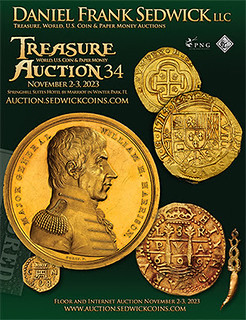 This catalog is packed with numerous rarities, unique pieces, and beautiful coinage designs that could possibly find a new home in your collection!
This catalog is packed with numerous rarities, unique pieces, and beautiful coinage designs that could possibly find a new home in your collection!
We'll begin our 34th Treasure Auction with some truly impressive rarities in Gold Cobs. To highlight a few 1715 Fleet treasure coins: a boldy struck Mexico City, Mexico, 1714 J cob 8 escudos graded NGC MS 62 (lot 23); a Royal-like Lima, Peru, 1699 R cob 8 escudos with excellent strike and original as-found surfaces (lot 32); and a Lima, Peru, 1710 H cob 8 escudos graded NGC MS 63 linked to the very first offering of 1715 Fleet coins from the Real Eight Company (lot 36).
The treasure in Shipwreck Ingots is led by a cut gold tumbaga
bar weighing 307 grams from the Tumbaga Wreck
(lot 59) as well as a large, Class Factor 1.0 silver ingot weighing over 79 troy pounds from the Atocha (lot 65). U.S. shipwreck enthusiasts should watch for the large PCGS slab containing 5 troy ounces of gold nuggets and dust recovered from the SS Central America shipwreck (lot 60).
For more Atocha treasure, the Shipwreck Coins section hosts not one but two(!) PCGS-graded gold cob 2 escudos from the Atocha shipwreck (lots 79 and 80) in addition to a large assortment of silver cob coins (lots 81-138). The 45th Anniversary Collection of coins recovered in 1978 from the Concepción shipwreck is a great opportunity to own at least one coin from this historical Spanish colonial treasure galleon (lots 150-239). Many pieces from the Akerendam (lots 348-372) and the HMS Association (lots 296-323) are also remarkable.
Our Mexico Silver Cobs section begins with selections from the Clyde Hubbard Collection, where rarities like a strongly struck 4 reales of Charles-Joanna with assayer O to left (lot 531) and a cob 8 reales of Philip II with assayer O graded NGC AU 53 (lot 582) are sure to stand out. Within Lima Silver Cobs, there are several date runs of very nice, fully dated 1/2 reales (lots 727-728, 730-731). Potosí Silver Cobs is crowned by two unique 1736-dated 8 and 4 reales Hearts (lots 857 and 907) in their first auction appearances ever.
Our gigantic World Coins session hosts several noteworthy collections. One of the most important Colombian coin collections, the Gregorio Toulemonde Collection, will be sold with such rarities as the very difficult Bogotá 1759 JV pillar 8 reales graded NGC AU 55 (lot 1105) immediately followed by the high-grade Bogotá 1770 VJ pillar 8 reales graded NGC MS 63 (lot 1106). We are particularly excited to offer the Warren Baker Collection of Canadian colonial tokens, a lifetime assemblage of some of the best or most difficult early Canadian token designs (lots 997-1040). Incredible Chilean coinage types, desirable in rarity and grade, will cross the block through the Val y Mexia Collection.
Other notable areas of interest include a selection of beautiful Bolivian monetary medals (lots 972-991); several key Chinese type coins including the Sun Yat-sen silver dollar of Year 21 (1932) with birds over junk graded PCGS MS62 (lot 1103); a great variety of Costa Rican countermarked and counterstamped coinages (lots 1225-1250) alongside a gorgeous—not to mention rare—Costa Rican gold 1873 GW 20 pesos graded NGC MS 63 (lot 1251); an unprecedented group of Guatemala gold bust coins (lots 1320-1331); a very rare and desirable Olancho, Honduras, 8 reales-sized proclamation medal from 1808 graded PCGS AU50 (lot 1365); and the finest selection of Panama cob coins we have ever offered, topped by the incredibly rare and finest known cob 4 reales of assayer oB graded NGC AU 55, which is plated in several key numismatic references (lot 1445).
Within Medals and Decorations, we host our fifth—and final—offering of top Admiral Vernon medals from the John Adams Collection (lots 1524-1594), many of which are plated in the fantastic reference book he co-wrote alongside Fernando Chao.
Following that, a once-in-a-lifetime opportunity will occur as we offer the unique 1818-dated Congressional Gold Medal awarded to President William Henry Harrison for his role in the victory at the Battle of the Thames during the War of 1812 (lot 1609). This historical piece of American presidential history was presented in 1825 to Harrison by President James Monroe. After Harrison's death in 1841, just 32 days in the nation's highest office, it was passed down through his family. Eventually, Harrison's grandson, President Benjamin Harrison, acquired the medal. Today, it exists as the only War of 1812 Congressional Gold Medal awarded to a U.S. president available for private sale.
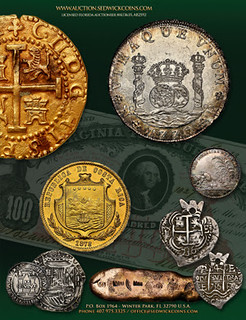 A special highlight in U.S. Paper Money is the Civil War-era Virginia $100 Treasury Note graded PMG AU 55 (lot 1614). Only 83 examples were left outstanding in 1863 and fewer than a dozen survivors in any condition are known today.
World Paper Money features two finest-known PMG-graded Latin American rarities—the Guatemala Banco Internacional 1 peso of 1879 with handwritten date (Pick-151a) graded PMG Choice UNC 63 EPQ (lot 1628) and the Paraguay 20 pesos fuertes of 1894 graded PMG Choice Fine 15 (lot 1633).
A special highlight in U.S. Paper Money is the Civil War-era Virginia $100 Treasury Note graded PMG AU 55 (lot 1614). Only 83 examples were left outstanding in 1863 and fewer than a dozen survivors in any condition are known today.
World Paper Money features two finest-known PMG-graded Latin American rarities—the Guatemala Banco Internacional 1 peso of 1879 with handwritten date (Pick-151a) graded PMG Choice UNC 63 EPQ (lot 1628) and the Paraguay 20 pesos fuertes of 1894 graded PMG Choice Fine 15 (lot 1633).
Ancient Coins contains several popular types such as the Calabria boy on dolphin
didrachm and the religious Byzantine Empire gold designs. Our popular Coin Jewelry section hosts several gold cob escudos and shipwreck coins already mounted in jewelry settings and ready to wear. Shipwreck Artifacts has an ornate gold toothpick with a hand-carved design of intertwined sea serpents recovered from the Corrigans site of the 1715 Fleet (lot 1700), plus a silver plate from the 1641 Concepción that represents the first artifact we have ever offered from that wreck (lot 1693). Following that, Non-Wreck Artifacts features both man-made and natural artifacts of many time periods.
This auction then finishes with the online-only Express session of varied numismatic items. Thank you to our valued consignors and good luck to all of our bidders looking for that next great piece for their collection!
For more information, see:
https://auction.sedwickcoins.com/
TCNC 2023 EXTRAVAGANZA II SALE
The Canadian Numismatic Company's 2023 Extravaganza II Sale closes November 11-14. Here's the announcement. -Editor
 Welcome to The 2023 Extravaganza II auction Sale of the Toronto Collection , the
Welcome to The 2023 Extravaganza II auction Sale of the Toronto Collection , the Little Collection
Part V and a selection of the Brown Family Collection
. This auction of more than 1,900 numismatic & Militaria lots features several collections joined by selections from 91 other consignors across North America.
The first and second Sessions are highlighted by three attractive coin, medal and banknote collections. A great selection from the Brown Family Collection
of Canadian banknotes, the Little Collection Part V of Canadian coins, the Toronto Collection
of Canadian coins and banknotes. Also featuring in this auction: an elusive 1921 50 cents PCGS choice Mint State-63; three Indian Chief Medals treaty No. 2, No. 3 and a Victorian copper. An ultra rare Pattern from New Brunswick dated 1862 graded PCGS Choice Specimen-62; a 1936 25¢ with the Bar variety in PCGS Superb Gem Mint State-66 with great eye appeal; a magnificent 1944 Specimen set; a beautiful 1935 $100 French issue in UNC-62; a stunning 1935 $100 English issue in Gem UNC-66PPQ. An amazing and excessively rare 1918 $50,000 Bank Legal Front & Back Proofs; the rarest Canadian Gold sovereign 1916-C in PCGS MS64; a choice 1913 Broad Leaves 10 cents in Choice MS63; the finest 1871 25 cents Obverse 1 PCGS MS62.
In addition, a superb selection of Gold coinage from Worldwide, Canada & USA. The Toronto Collection Part 1 holds a premium selection of Chartered banknotes and several others including Rare Serial number issues and error notes. The Brown Family Collection
Part 1 offers several top graded banknotes. The two Jewels of this selection are the excessively rare 1935 $500 in VF condition, the most sought after Bank of Canada banknote; and a 1937 $1000 in Superb Gem Uncirculated-67. Both are excessively rare and desirable. Several other attractive and stunning issues. A superb assortment of tokens and RCM tokens are listed in session 3. Each piece has been carefully selected and is attractive and proper for the grade attributed, some unusual varieties and attractive issues.
This fantastic 2023 Extravaganza II Auction sale event should make some spectacular moments and active evenings of auctioning. We expect this to be one of the prestigious numismatic events of 2023 featuring several rarities never offered to the public. Our sincere thanks to the consignors for entrusting us with the fantastic task of selling their collections. We hope you enjoy this catalogue as much as we enjoyed making it. This should be a memorable sale!
To view the auction lots online, see:
https://auctions.canadiancoinsandpapermoney.com/auction/222/the-extravaganza-sale-ii-major-sale
To view the .pdf catalog, see:
https://www.canadiancoinsandpapermoney.com/wp-content/uploads/2023/10/Extravaganza-II-Sale-.pdf
KUENKER AUCTIONS 395-397, PART 1
Künker will hold five auction sales in November. Here's the first part of the press release detailing highlights of sales 395-397. -Editor
Ancient Roman coins for connoisseurs with a deep interest in Roman history, a cross-section of coins from the ancient world including numerous gold issues as well as spectacular orders and decorations with magnificent provenances – this is the focus of Künker's public auctions in November.
Orders and medals from the estate of the Silesian line of the House of Württemberg as well as a spectacular private collection of Prussian orders and decorations – this is the offer that awaits phaleristic enthusiasts at Künker's order auction on 13 November 2023. Lovers of ancient issues can, among other things, look forward to 1st-century Roman Republican coinage as well as early imperial issues from the Dr. W. R. Collection. Part 7 and 8 focus on great rarities of the Roman imperators and provincial Roman coinage. Next is auction 397 with a wide scope of ancient coins, including pieces from the Dr. Kurt Conzen Collection and gold coins from the collection of the Luxembourg notary Maître Robert Schuman.
Auction 396 – The Dr. W. R. Collection Part 7 and 8
Two more parts of the Dr. W. R. Collection will be on sale at auction 396 on 13 and 14 November 2023 in Osnabrück. The sale starts with a spectacular series of Roman provincial coinage with the names of Roman officials. As these pieces are of great scientific importance, Johannes Nollé wrote a detailed commentary about the matter. Those who are interested in more than the usual Roman emperors will encounter Roman officials such as Proconsul Q. Hortensius Hortalus and Proconsul M. Tullius Cicero – the sons of much more famous politicians of the same names– or the Roman self-made man Vedius Pollio. But there are also better-known personalities on offer such as Publius Quinctilius Varus or the Praefectus of Judaea, Pontius Pilate.
Part 8 of the Dr. W. R. Collection is a perfect opportunity for all those who want to add coins of the imperators and especially of relatives of the Twelve Caesars to their collections. The ensemble includes eleven coins of the family of Pompey, namely of all three politically active members, Pompey Magnus and his two sons. 17 coins related to Caesar are on offer as well as the issues of his assassins, including a denarius with the extremely rare portrait of Brutus.
Are you looking for a portrait of the early deceased grandsons of Augustus, Caius and Lucius? Auction 396 offers many pieces to choose from, in addition to coins from the notorious sisters of Caligula, Drusilla and Livilla. Or would you like a portrait of Britannicus, the early deceased son of Claudius who should have come to power instead of Nero? The Dr. W. R. Collection contains as many as five pieces with his portrait. And it should also be mentioned that, in addition, there are interesting denarii and bronze issues on offer, including some aurei of the classic Twelve Caesars.
No. 1013: Achulla / Africa Propria (today's Tunisia). Bronze coin, 8/7 BC. Obv. Portraits of Augustus with Gaius and Lucius. Rv. Portrait of Publius Quinctilius Varus. Extremely rare. About fine. Estimate: 4,000 euros
By supporting Rome in the Third Punic War, Achulla gained the status of a free city. On its coins, the city fathers not only depicted the emperor but also Roman governors. One of them is Publius Quinctilius Varus, who became famous due to his failure in the Teutoburg Forest.
No. 1017: Macedonia. Bronze coin, before Caesar's death(?), Dion or Kassandreia. Head of Q. Hortensius Hortalus. Rv. Yoke, plough and yardstick with vexillum. Very rare. Fine +. Estimate: 1,500 euros
Quintus Hortensius Hortalus was the son of the famous public speaker of the same name, to whom Cicero dedicated a tract. Young Hortalus was a partisan of Caesar and among the first to cross the Rubicon. For his efforts, he was rewarded with the position as governor of the province of Macedonia. After Caesar's death, Octavian and Marcus Antonius planned to take it away from him. As a result, Hortalus joined Caesar's assassins. In this way, he could remain a proconsul while Brutus was the de facto ruler. However, Hortalus backed the wrong horse. After the defeat of Caesar's assassins in the Battle of Philippi, Hortalus was executed.
No. 1112: Q. Caecilius Metellus Pius Scipio and Marcus Eppius. Denarius, 47/6, African mint. Extremely fine +. Estimate: 1,000 euros
No. 1124: C. Iulius Caesar. Denarius, 44 BC. Very rare. About extremely fine. Estimate: 3,000 euros
No. 1134: Marcus Iunius Brutus and L. Servius Rufus. Denarius, 43. Very rare. Very fine. Estimate: 4,000 euros
No. 1143: Cn. Domitius Ahenobarbus. Denarius, 41 BC, unknown mint. From Sternberg auction XVIII (1986), No. 374. Rare. Extremely fine. Estimate: 6,000 euros
No. 1292: Tiberius and L. Aelius Sejanus. As, 31, Bilbilis (Hispania). From the Leo Benz Collection, Lanz auction 94 (1999), No. 162. About extremely fine. Estimate: 1,500 euros
Lucius Aelius Sejanus was a prefect of the Praetorian Guard under Tiberius, who had withdrawn to the island of Capri. Since the emperor was not around, Sejanus virtually became the most powerful man in Rome. He was brought down in 31. It is impossible to verify whether he actually planned to murder Caligula and wanted the imperial throne for himself. The sources are too biased and do not allow us to objectively assess the situation. Sejanus fell victim to the damnatio memoriae after he died. Therefore, his name was erased from coins. Regarding this piece, his name is still visible.
No. 1332: Caligula and Drusilla. Miletus (Ionia). Bronze coin, after 38. Very rare. Extremely fine. Estimate: 1,250 euros
No. 1368: Claudius with Britannicus, Claudia and Claudia Octavia. Patras (Peloponnese). Bronze coin, around 41-45. Very rare. About extremely fine. Estimate: 2,500 euros
No. 1400: Nero and Agrippina Junior. Denarius, 54. Rare. Very fine +. Estimate: 1,000 euros
NUMISMATIC NUGGETS: OCTOBER 15, 2023
Here's a selection of interesting or unusual items I came across in the marketplace this week. Tell us what you think of some of these. -Editor
Square Drachm of Apollodotos I
BACTRIA: Apollodotos I, ca. 180-160 BC, AR square drachm (2.33g), Bop-4G, elephant right, monogram below // humped bull right, monogram below, lightly wavy flan, VF.
My wife collects elephants (not real ones), so this piece in the Stephen Album Internet Auction 23 caught my eye. It's also an unusual shape - I think this is the first coin I've seen of this era that's square. -Editor
To read the complete lot description, see:
BACTRIA: Apollodotos I, ca. 180-160 BC, AR square drachm (2.33g), VF
(https://www.sarc.auction/BACTRIA-Apollodotos-I-ca-180-160-BC-AR-square-drachm-2-33g-VF_i50550246)
1927 Canadian Five Cent Piece
Canada 1927 5 Cents PCGS MS65 $1,250
The last APR in MS65 brought $1410.
Certification Number: 6720990
I've always liked the Canadian nickels. Nice clean, balanced design with a bold "5". From the Northeast Numismatics website. -Editor
To read the complete lot description, see:
Canada 1927 5 Cents PCGS MS65
(https://www.northeastcoin.com/popupcontainer.jsp?include=vi&itemKey=zi29_1000261829)
First Commemorative Mint Item
Laminated photograph of Yosef Yitzchak Schneersohn on board, and coins from 1940 given as a token to the members of R' Michel's minyan. Inserted into the original plastic folding booklet.
Yosef Yitzchak Schneersohn- June 1880 – 28 January 1950, was an Orthodox rabbi and the sixth Rebbe of the Chabad Lubavitch Hasidic movement. He is also known as the Frierdiker Rebbe the Rebbe RaYYaTz, or the Rebbe Rayatz (an acronym for Rabbi Yosef Yitzchak). After many years of fighting to keep Orthodox Judaism alive from within the Soviet Union, he was forced to leave; he continued to conduct the struggle from Latvia, and then Poland, and eventually the United States, where he spent the last ten years of his life.
This odd item had me scratching my head - why does it exist? What do a handful of circulated U.S. coins have to do with the subject? "First Commemorative Mint Inc." is still around and their website says they were established in 2002, so this was assembled long after the 1940s. -Editor
To read the complete lot description, see:
A Commemorative Gift from R' Michel's Minyan 1940
(https://www.appelauction.com/auction/241-appel-online-2-en/lot-40-a-commemorative/)
Victor Demanet Art Medal
Belgium, Medal, Art Déco, Le Travailleur, 1976, Victor Demanet, AU
A great medal design offered on eBay from NumisCorner. -Editor
To read the complete lot description, see:
[#181440] Belgium, Medal, Art Déco, Le Travailleur, 1976, Victor Demanet, AU
(https://www.ebay.com/itm/144480975927)
1862 Virginia Savings Bank Presentation Goblet
American Silver Repousse Presentation Goblet, unmarked, engraved "Presented to/ S.S. Cottrell/ by/ The Va. Savings Bank/ 1862", bell-shaped cup on spreading foot, lotus leaf and bud chasing. Note: Probably Samuel Smith Cottrell (1819-1903), of Cottrell Saddlery & Harness of Richmond, VA, which furnished the Armies of the Confederacy with harness.
While not numismatic, I thought this was a fascinating piece of Civil War history connected to a Virginia bank. -Editor
To read the complete lot description, see:
American Silver Repousse Presentation Goblet
(https://www.nealauction.com/auction-lot/american-coin-silver-repousse-presentation-goblet_F2940F9866)
NORRIS MUSEUM DISPLAYS THE MUDDY HOARD
A temporary exhibition at the Norris Museum in St. Ives, UK displays thousands of Roman coins discovered in May 2018. -Editor
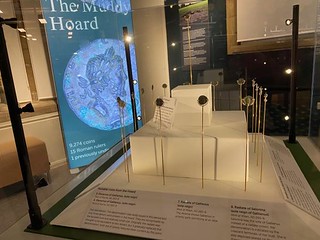 Rare Roman coins discovered by a metal detectorist in Huntingdonshire have gone on display in St Ives.
Rare Roman coins discovered by a metal detectorist in Huntingdonshire have gone on display in St Ives.
The Norris Museum has set up a temporary exhibition called The Muddy Hoard to display the hoard which contains some 9.2k coins, across the reign of 14 emperors and one empress.
Given the quantity, composition, and quality of some of the coins, the museum says the hoard could be counted as one of the 10 most significant Roman coin hoards found in the UK, and it includes a previously unrecorded coin – a denarius of Emperor Tetricus I.
It is by far the most significant acquisition The Norris Museum has ever secured and fundraising for its permanent display has been set up in the museum's main gallery.
 "The exhibition will evolve through its run, with live demonstrations of pottery reconstruction, talks about the Portable Antiquities Scheme, a celebration of archaeology, as well as ongoing conservation work, and research on the coins," said a spokesperson for the museum.
"The exhibition will evolve through its run, with live demonstrations of pottery reconstruction, talks about the Portable Antiquities Scheme, a celebration of archaeology, as well as ongoing conservation work, and research on the coins," said a spokesperson for the museum.
The hoard of coins was discovered in May 2018 about nine miles north of Huntingdon by a metal detectorist.
To read the complete article, see:
Roman coins found in Huntingdon on display in St Ives
(https://www.huntspost.co.uk/news/23826699.roman-coins-found-huntingdon-display-st-ives/)
HAN DYNASTY COIN HOARD FOUND
Leon Saryan passed along this story of an interesting find in China. Thank you! -Editor
Archaeologists excavated the playground of an elementary school in the eastern coastal city of Ningbo ahead of planned construction, the Institute of Archaeology at the Chinese Academy of Social Sciences said in an Oct. 10 news release.
The excavations uncovered 65 pits, eight wells and several other structures all over 1,400 years old, the release said. Archaeologists identified the ruins as part of a settlement.
In one storage pit, archaeologists found 796 copper coins in tied-up stacks. A photo shows the stash of muddy coins with square holes in the center. In one of the wells, they unearthed 1,682 more coins.
Based on the number of coins and their style of burial, archaeologists concluded the treasures were buried as an emergency measure by residents who feared a disaster was coming, the release said. The age and location of the coins match — and might be linked to — a period of rebellion and famine in the sixth century A.D.
The artifacts mainly date from the Han dynasty, a period from 206 B.C. to 220 A.D., and the Six Dynasties, a period from 220 A.D. to 589 A.D, according to the release and Encyclopedia Britannica.
To read the complete article, see:
Treasure stash — buried in emergency 1,400 years ago — found under playground in China
(https://ca.news.yahoo.com/treasure-stash-buried-emergency-1-175653686.html)
COIN HOARD LINKED TO 1692 GLENCOE MASSACRE
An archaeology student on her first dig found an important coin hoard in Scotland. -Editor
Coins found under a fireplace may have been hidden there by a victim of the infamous Massacre of Glencoe, according to archaeologists.
Almost 40 members of Clan MacDonald of Glencoe were killed in February 1692 after soldiers were ordered to attack them.
A student discovered the money at the site of a house linked to the clan's chief.
The 36 coins were inside a pot which had a small round pebble as a lid and had been placed beneath a hearth stone slab in the fireplace.
The discovery was made in August during an excavation at the site of the ruined house, led by archaeologists from the University of Glasgow.
The property was associated with clan chief Alasdair Ruadh "MacIain" MacDonald of Glencoe.
He was among the estimated 38 people killed in the massacre.
The MacDonalds were targeted because of their support for the exiled King James VII of Scotland and II of England.
The clan backed the restoration of the Stuart dynasty to the British throne and had taken part in the first Jacobite Rising of 1689.
None of the coins were minted after the 1680s, which has led archaeologists to suggest they were most likely deposited under the fireplace either just before or during the killings for safekeeping.
The archaeologists also said whoever buried the coins did not return for them, possibly indicating they were among the victims of the massacre.
The coins are dated from the late 1500s through to the 1680s, and include pieces from the reigns of Elizabeth I, James VI and I, Charles I, the Cromwellian Commonwealth, and Charles II.
Thanks also to Larry Edwards for passing along the story. -Editor
To read the complete articles, see:
Coin hoard could be linked to 1692's Glencoe Massacre
(https://www.bbc.com/news/uk-scotland-highlands-islands-67031984)
300-Year-Old Coins Found Under Fireplace May Be Connected to the Glencoe Massacre
(https://www.smithsonianmag.com/smart-news/300-year-old-coins-found-under-fireplace-may-be-connected-to-the-glencoe-massacre-180983067/)
NEW KING CHARLES III COINS ANNOUNCED
The Royal Mint has announced a redesigned set of UK coins featuring King Charles III. Thanks to David Pickup for passing this along. -Editor
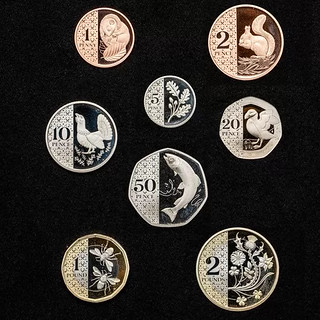 Large numbers on an entirely redesigned set of UK coins will help children to identify figures and learn to count, The Royal Mint has said.
Large numbers on an entirely redesigned set of UK coins will help children to identify figures and learn to count, The Royal Mint has said.
The coins will enter circulation by the end of the year, marking the new reign of King Charles III and celebrating his love of the natural world.
The tails side of every coin from the 1p to the £2 will feature the country's flora and fauna.
Old coins can still be used, with the new set struck in response to demand.
The BBC was given an advance viewing of the new coins, the size and shape of which remain unchanged.
Although there have been commemorative coins circulating featuring King Charles, these new designs - officially known as definitives - mark the final chapter of the King's transition onto coinage.
Definitive coins feature the standard designs seen on the majority of official currency. These designs stay the same for years or even decades.
Animals ranging from the red squirrel to the capercaillie grouse are depicted on the new designs. The King's now-familiar portrait will be on the front of each coin - many for the first time.
The reverse, or tails side, of the new coins will be the matter of most interest to collectors and for quizmasters. They are designed to show the importance, and precariousness, of the natural world:
- 1p: A hazel dormouse, which has seen its population halve since 2007
- 2p: A red squirrel, which is expected to blend into the colour of the copper coin
- 5p: An oak tree leaf, signifying its role as a rich habitat for biodiversity in woodland areas and an association with monarchy of the past
- 10p: The capercaillie - the world's largest grouse - found in a small part of Scotland and threatened with extinction
- 20p: A puffin
- 50p: The Atlantic salmon, which is at threat from river pollution and habitat loss
- £1: Bees
- £2: National flowers - a rose for England, a daffodil for Wales, a thistle for Scotland and a shamrock for Northern Ireland
Three interlocking Cs feature on the coins, representing the third King Charles, and taking its inspiration from the cypher of Charles II.
The edge inscription of the new £2 coin was chosen by the new King Charles and reads: "In servitio omnium", which means: "In the service of all".
It was taken from his inaugural speech in September last year.
David adds:
"As Charles Riley has pointed out the new designs on the new coinage have similarities with the Irish pre-decimal coins from the 1920s.
"I wonder if the new coins will eventually get nicknames such as squirrel
salmon
and grouse
."
That's possible. Time will tell. Thanks also to Pabitra Saha for passing along the news. -Editor
To read the complete article, see:
King Charles III new coins designed to help children to count
(https://www.bbc.com/news/business-67091137)
Dick Hanscom passed along these two videos of the coins. Thanks. -Editor
To watch the videos, see:
https://www.msn.com/en-us/money/personalfinance/uk-unveils-new-coins-that-will-go-into-circulation/vi-AA1icXCr
WYATT COPY OF MAJOR ANDRE MEDAL OFFERED
Robert Fagaly alerted me to this lot in the upcoming Stack's Bowers Syd Martin V auction that relates to an earlier article. Thank you. Very interesting piece. -Editor
(Ca. 1848) cast copy of the Capture of Andre Medal. As Betts-576. Copper over lead, 60.0 x 42.2 mm. Extremely Fine.
A 19th century copy, produced by Thomas Wyatt as part of the series of copy medals produced to accompany his 1848 book Memoirs of the Generals, Commodores, And Other Commanders: Who Distinguished Themselves in the American Army and Navy during the Wars of the Revolution and 1812, And Who Were Presented with Medals by Congress, For Their Gallant Services. While the best known made-from-whole-cloth copy from Wyatt's project was the "mystery dies" Henry Lee medal, the set also included this replica of the first medal ordered by Congress to have actually been created and presented: the Capture of Andre or "Fidelity" medal awarded to John Paulding, David Williams, and Isaac Van Wart.
Two of the three original medals, handcrafted in silver, struck in repousse and then hand-engraved, survived into the late 20th century. The New-York Historical Society had both Paulding's and Williams' medals (the latter of which was illustrated in the New-York Historical Society Quarterly Bulletin of July 1923) until they were stolen, along with John Andre's watch, from a locked case in June 1975. A faithful silver plated copy of the Paulding medal has been in the ANS collection since 1945, with a fully engraved presentation inscription on the reverse, a contrast with the simple engraved monograph on the reverse of the Williams specimen. The Van Wart medal has not been traced into modern times.
While the editors of Betts, in the footnote on page 267, relate that far more than three were made because a Charles Pryor showed one to the ANS in 1891, "one was in the Vattemare Collection, and others are known," it's almost certain that these other pieces were Wyatt copies like this or other sorts of replicas. The two known to have survived into modern times both remained with descendants into the 20th century. Like Wyatt's Lee medal, this appears to have been copied from one of the many printed engravings of the medals that were published in the early 19th century, as the common engraving shows a blank space on the reverse, as seen here, while the originals were uniquely engraved.
This is a nicer example of this copy than most seen, and it appears to be an "original" copy rather than one of the cruder aftercasts we have encountered. Some lead shows through at the edge and a few high points, but the surfaces are otherwise choice in appearance and retain a nice chocolate brown tone.
The occasion of Maj. John Andre's capture and conviction was so important to the American cause that Congress not only authorized and produced these medals for the three men involved - a full decade before any Comitia Americana medal was actually awarded - but George Washington himself presented the medals to each of the three men. Andre was hanged in Tappan, New York on October 2, 1780. His mortal remains now rest beneath a majestic memorial at Westminster Abbey.
 "The Van Wart medal has not been traced into modern times." Ahem.
If only there were a weekly numismatic publication published on the open internet that one could consult for up-to-date information...
"The Van Wart medal has not been traced into modern times." Ahem.
If only there were a weekly numismatic publication published on the open internet that one could consult for up-to-date information...
Actually, I probably shouldn't be snarky about this. Who among us has the time to read and absorb all the great numismatic news and information being published today? Not me, and I read a LOT. It's a firehose of information, and I'd be a liar if I said I'd read every word of even the books published by my close friends, let alone the rest of the numismatic world. The best we can hope for is the kindness of fellow numismatists who gently point out what we've missed. -Editor
To read the complete lot description, see:
(Ca. 1848) cast copy of the Capture of Andre Medal. As Betts-576. Copper over lead, 60.0 x 42.2 mm. Extremely Fine.
(https://auctions.stacksbowers.com/lots/view/3-1621P6/ca-1848-cast-copy-of-the-capture-of-andre-medal-as-betts-576-copper-over-lead-600-x-422-mm-extremely-fine)
To read the earlier E-Sylum article, see:
MUSEUM ACQUIRES VINCIT AMOR PATRIAE MEDAL
(https://www.coinbooks.org/v26/esylum_v26n30a12.html)
HERITAGE OFFERS ARCHITECTURAL MEDALS
An item on the October 6, 2023 Heritage World and Ancient Coin News email highlights some Jacques Wiener architectural medals in their November 13th sale. -Editor
As our upcoming November 13th Spotlight Auction approaches, The Medals and Tokens World Coins Showcase #61328, we are thrilled to present a selection from Jacques Wiener, the renowned 19th-century Belgian medalist. A virtuoso in his field, Wiener's profound style has ensured a lasting numismatic legacy as his medals continue to grace prestigious collections worldwide.
Born in Belgium in 1815, Jacques Wiener hails from a distinguished line of artisans. His body of work, monumental in its detail and precise architecture, shook up the continental medallion scene. Famously known for his acclaimed Cathedral Series, Wiener rendered a realistic snapshot of grand cathedrals across Europe. The obverse features the front of the cathedral (or building), while the reverse consists of an eye-level view of the interior. The remarkable use of linear perspective within his interior architecture adds an astute illusion of depth, dynamism, and distance to flat bronze.
While Wiener's medallions are widely sought after by numismatic collectors, they are equally as attractive to connoisseurs of architectural design and European history. They are a tangible tribute to hundreds of years of culture, retelling tales of architectural elegance, forever frozen in aged patina.
As we stand in keen anticipation of the Spotlight auction, we invite you to explore the artistic and historical narratives embedded within these medals. Let Wiener's remarkable craftsmanship take you on a time-transcending journey to the icons of European grandeur, where architectural artistry reigned supreme.
To read the complete lot descriptions, see:
https://coins.ha.com/c/search-results.zx?N=3184+792+4294933677&Nty=1&Ntk=SI_Titles-Desc&Ntt=Wiener
FORGOTTEN THAILAND BANKNOTE HOARD FOUND
A family in Thailand discovered a long-hidden banknote hoard grandma had forgotten about. -Editor
A treasure trove of old banknotes, forgotten by their 90 year old owner, was discovered in a myriad of plastic bags during a house renovation. The elderly woman, Kang, had been living alone in her dilapidated home when her grandchildren began preparations to replace it with a sturdier three-storey structure, leading to this unprecedented banknote discovery.
Kang's 89 year old sister, Su, insisted on inspecting the contents of the plastic bags before they were discarded, despite their apparent disrepair. To their astonishment, nestled within the bundles of old clothing, were banknotes of varying denominations. The outdated currency, now of little practical use, held great value for collectors.
When questioned about the money, Kang admitted she had forgotten about its existence, suggesting her advancing age had clouded her memory of such past events.
In light of Kang's revelation, family members decided to thoroughly check every bag and sack in the house. Their diligence paid off when they found more tightly bound bundles of money, revealing the solitary woman had been meticulously saving for years. The total value of the find was estimated at 22 million dong, equivalent to around 32,000 baht, reported Sanook.
To read the complete article, see:
Lost and pound: Forgotten banknotes surface during house renovation revelation
(https://thethaiger.com/news/national/elderly-womans-forgotten-savings-of-32000-baht-discovered-during-house-renovation)
COIN TOSS ODDS? NOT 50/50
Scientists have discovered a natural bias that occurs when flipping a coin, with the side originally facing up being slightly favored. -Editor
A large team of researchers affiliated with multiple institutions across Europe, has found evidence backing up work by Persi Diaconis in 2007 in which he suggested tossed coins are more likely to land on the same side they started on, rather than on the reverse. The team conducted experiments designed to test the randomness of coin flipping and posted their results on the arXiv preprint server.
For many years, the coin toss (or flip) has represented a fair way to choose between two options—which side of a team goes first, for example, who wins a tied election, or gets to eat the last brownie. Over the years, many people have tested the randomness of coin tossing and most have found it to be as fair as expected—provided a fair coin is used.
But, Diaconis noted, such tests have only tested the likelihood that a fair coin, once flipped, has an equal chance of landing on heads or tails. They have not tested the likelihood of a fair coin landing with the same side up as that when it was flipped. He suggested that due to precession, a coin flipped into the air spends more time there with its initial side facing up, making it more likely to end up that way, as well. He suggested that the difference would be slight, however—just 1%. In this new effort, the research team tested Diaconis' ideas.
The experiment involved 48 people flipping coins minted in 46 countries (to prevent design bias) for a total of 350,757 coin flips. Each time, the participants noted whether the coin landed with the same side up as when it was launched. The researchers found that Diaconis was right—there was a slight bias. They found the coin landed with the same side up as when it was launched 50.8% of the time. They also found there was some slight variation in percentages between different individuals tossing coins.
The team concludes that while the bias they found is slight, it could be meaningful if multiple coin tosses are used to determine an outcome—for example, flipping a quarter 1,000 times and betting $1 each time (with winnings of 0 or 2$ each round) should result in an average overall win of $19.
Thanks also to Leon Saryan and Len Augsburger for passing along the story. -Editor
To read the complete articles, see:
Flipped coins found not to be as fair as thought
(https://phys.org/news/2023-10-flipped-coins-fair-thought.html)
Turns out a coin toss is "not so random after all," according to new study
(https://notthebee.com/article/turns-out-a-coin-toss-is-not-so-random-after-all-according-to-science)
Next time you flip a coin you might want to pick the side that's already facing up
(https://www.npr.org/2023/10/11/1205033611/next-time-you-flip-a-coin-you-might-want-to-pick-the-side-that-s-already-facing)
Coin tosses do not have 50/50 odds — here's how to pick the right side
(https://nypost.com/2023/10/11/coin-tosses-do-not-have-50-50-odds-how-to-pick-the-right-side/)
NUMISMATIC SMALL TALK
We love words here at The E-Sylum, Especially numismatic ones. Here's an article about a sports guy's uncomfortable encounter with one of us, headlined "The numismatist reckoned I was the most boring person he'd ever met." -Editor
 I want to share a horror story with you.
I want to share a horror story with you.
Many years ago, May 1999, my wife and I were invited to the home of her colleague. On arrival, the wives went off to make ooh and ahh noises about the stupidly expensive flowers we'd brought.
I was left with the husband, who I had never before met.
My conversational opening gambit was: Will Man U beat Bayern without Roy Keane in next week's Champions League Final?
Midfielder Keane was suspended, as was Paul Scholes. It was serious stuff.
The chap looked at me askance. He'd never heard of Roy Keane. And Scholes were sandals weren't they? He believed Manchester United wore red uniforms
, but his football knowledge ended there.
I broke into a cold sweat. How was I to make small talk with a man who didn't speak the universal language of football? By the time our wives came back 15 hours later (it felt) he was showing me his coin collection.
I'd been holding a 1930s five-lire piece for 10 minutes of quiet panic, with the only semi-intelligent thing I had found to say being: It's very round
.
After we left I imagine the numismatist told his wife: Don't invite them again, that bore knew nothing about Italian inter-war era coinage.
English is full of words which denote who is in, or not in, the club: whatever that club may be.
We all use codes. Any numismatist (not me, obviously) can identify an exergue. A plumber knows where grey water goes. An architect can place a corbel. An ophthalmologist is interested in your sclera. A chef might 86 it.
To read the complete article, see:
The numismatist reckoned I was the most boring person he'd ever met
(https://www.thecourier.co.uk/fp/columnists/4782346/the-numismatist-reckoned-i-was-the-most-boring-person-hed-ever-met/)
FEATURED WEBSITE: THE HERBSTMAN COLLECTION
This week's Featured Web Site is the Joe I. Herbstman Memorial Collection of American Finance. I was reminded of this one by News & Notes from the Society of Paper Money Collectors (Volume IX, Number 17, October 10, 2023).
The collection is specifically focused on the various federal loan instruments of the United States, from the earliest revolutionary loans to the last paper bonds issued in the 1980's. U.S. Treasury securities are the most important sovereign debt instruments within the global financial marketplace. The primary mission of The Herbstman Collection is to serve as an educational tool in teaching the history of these bonds and our national debt. My hope is that this collection serves as a lasting resource for generations to come.
https://www.theherbstmancollection.com/



